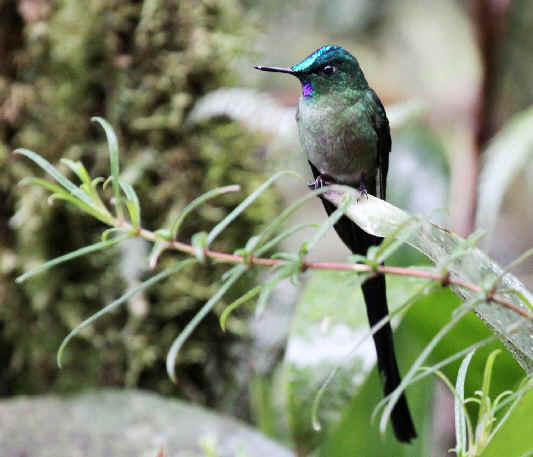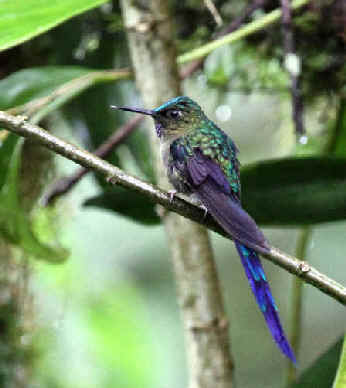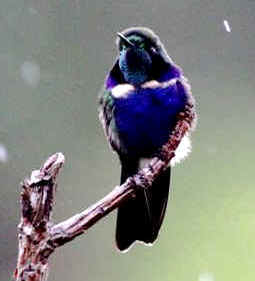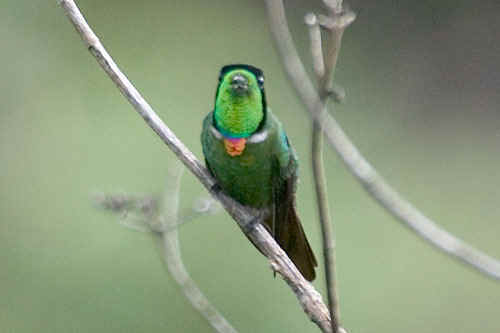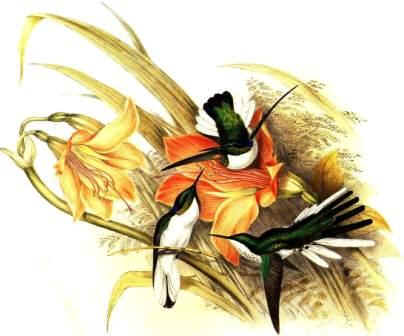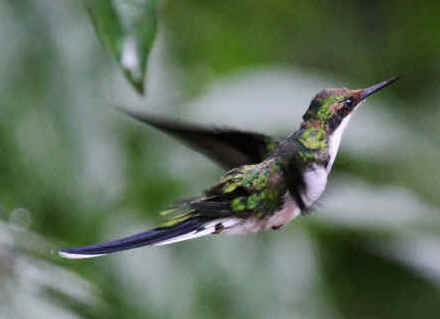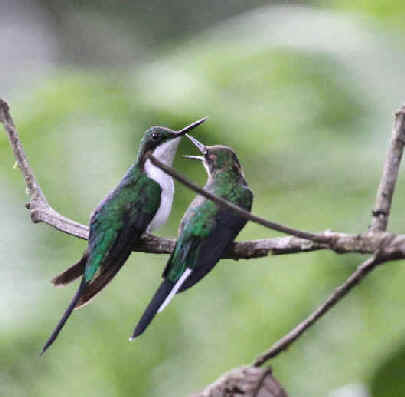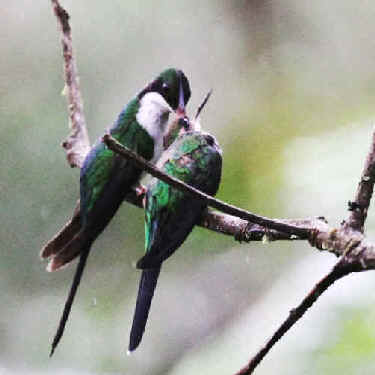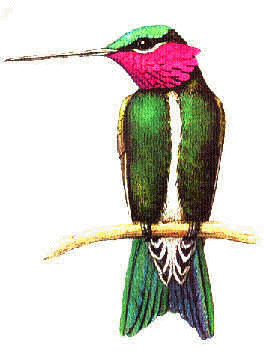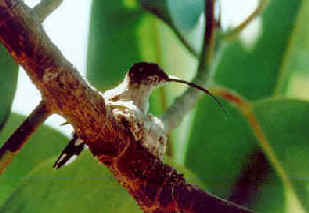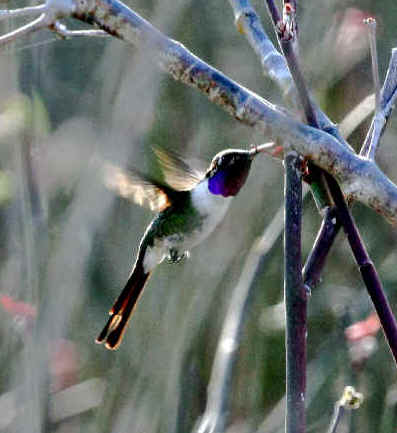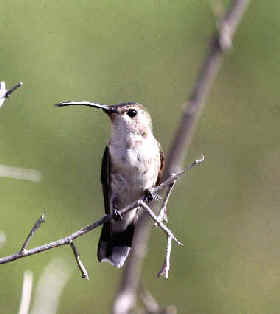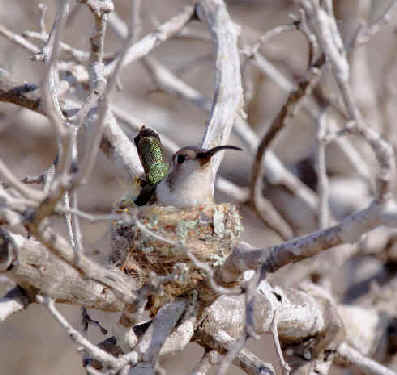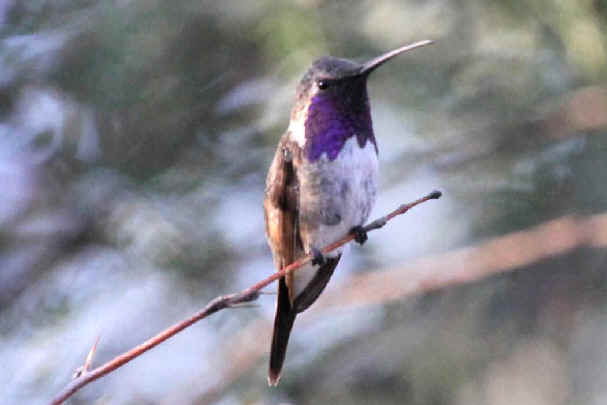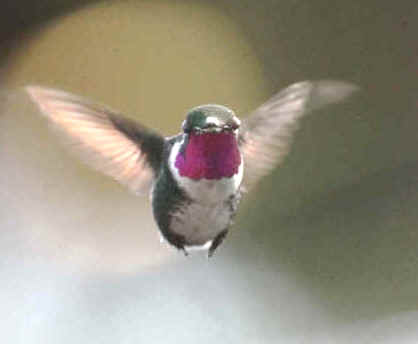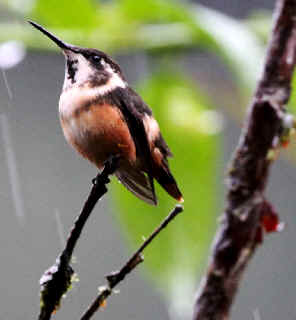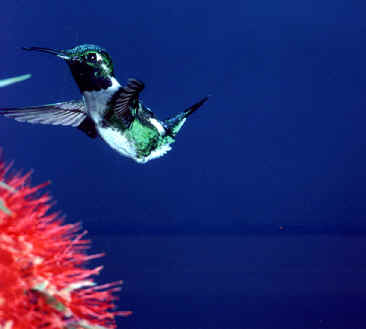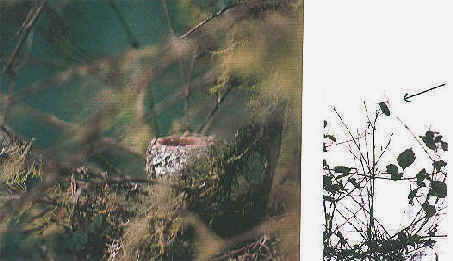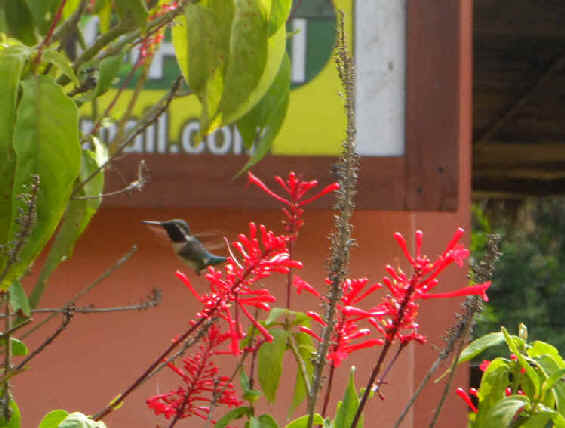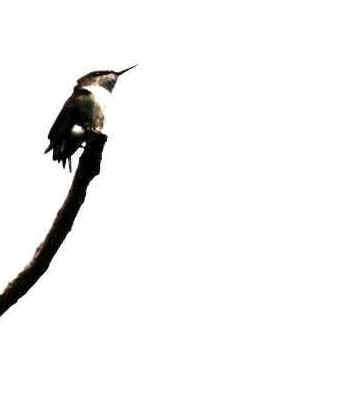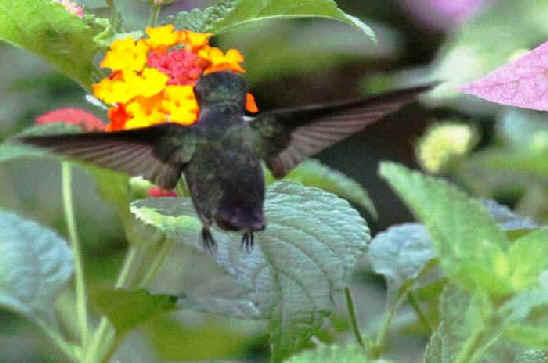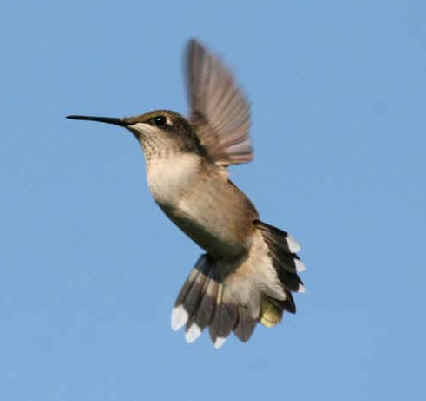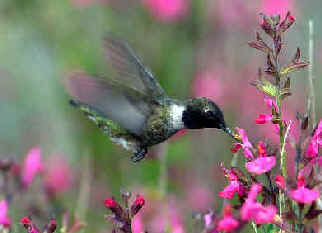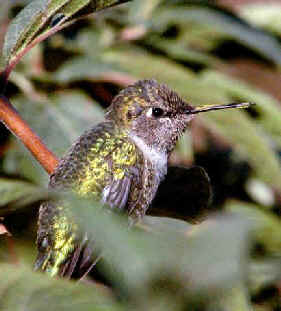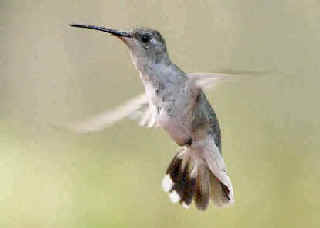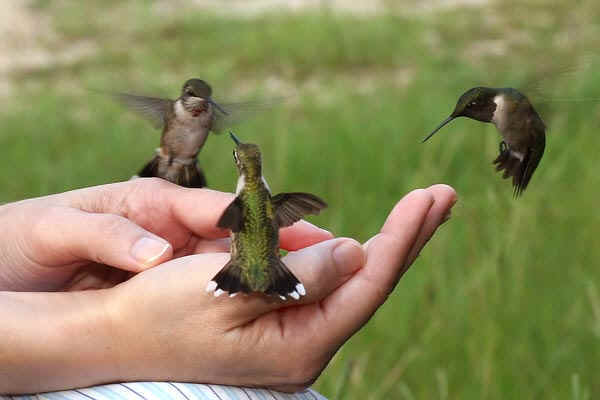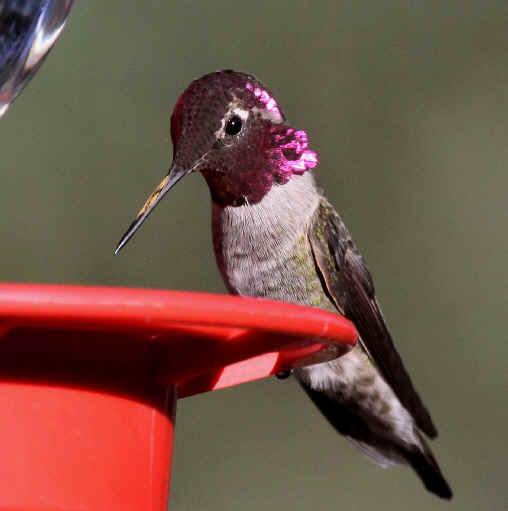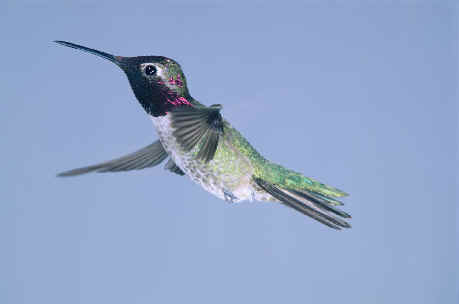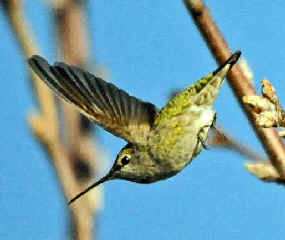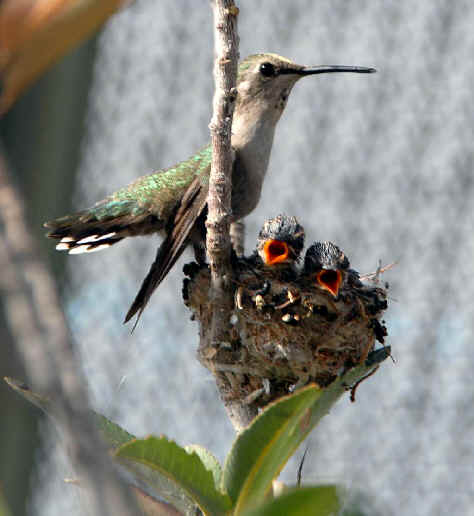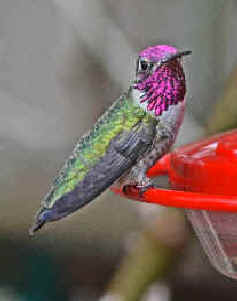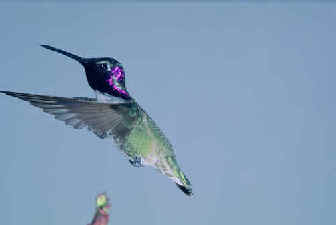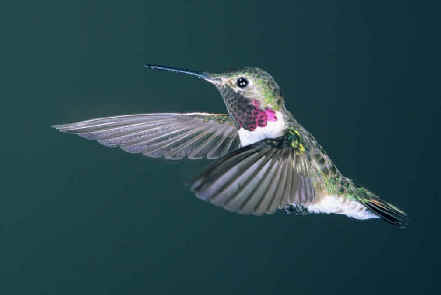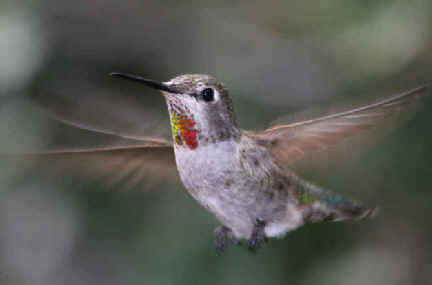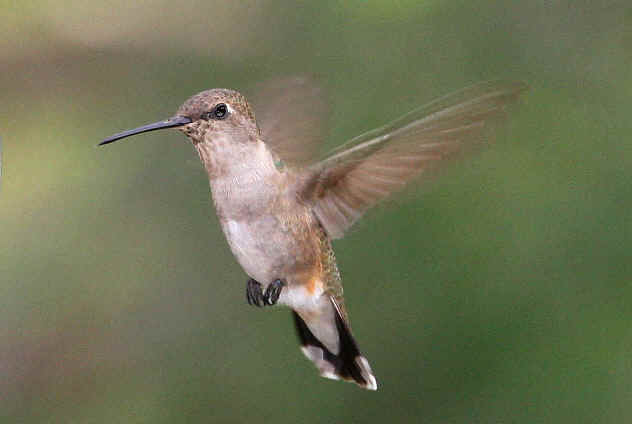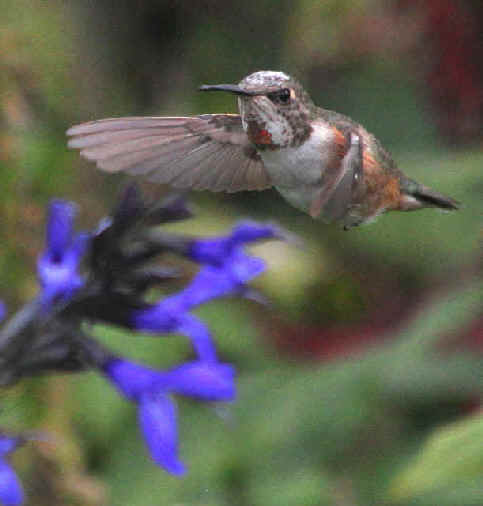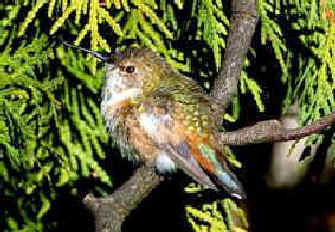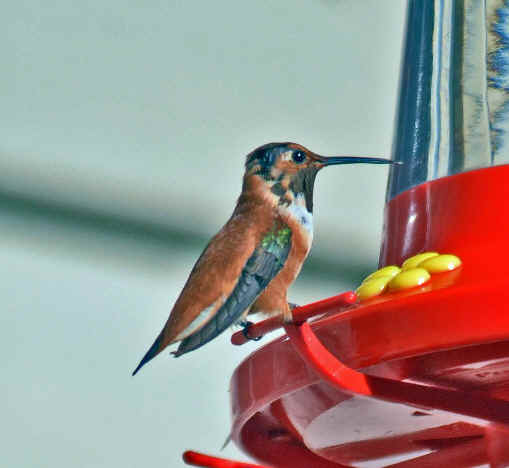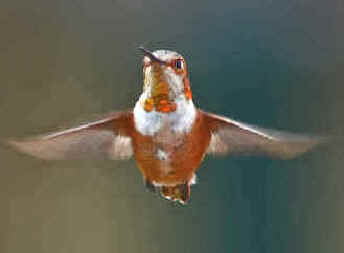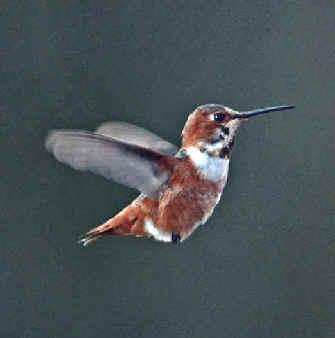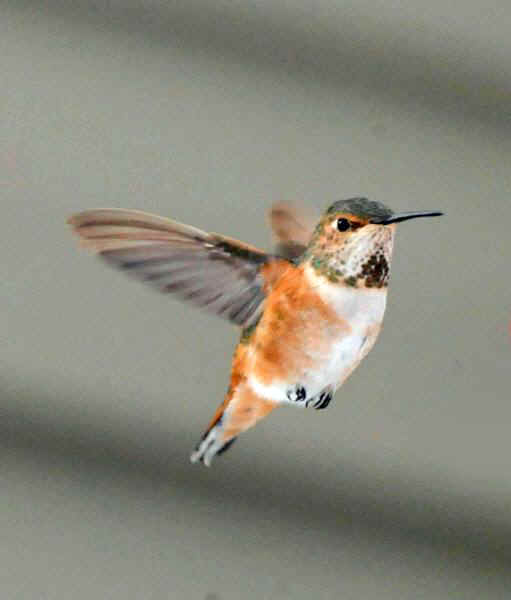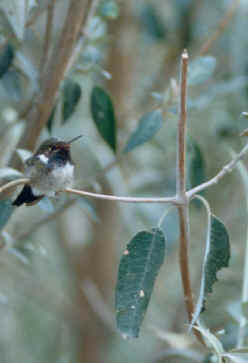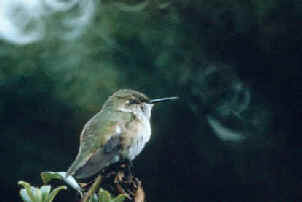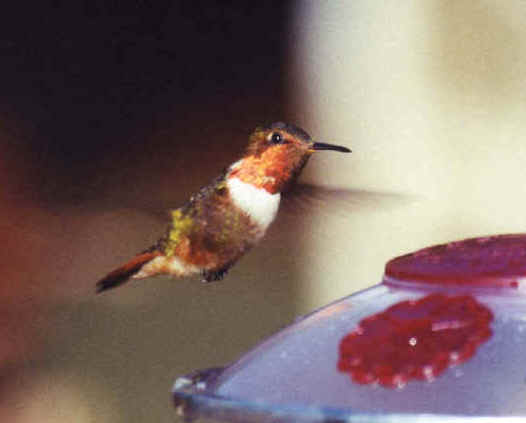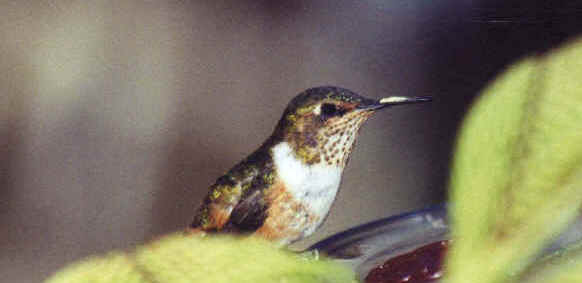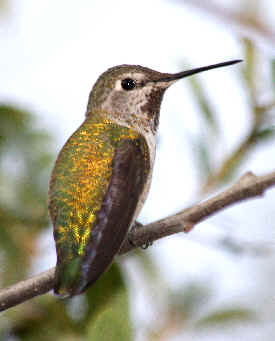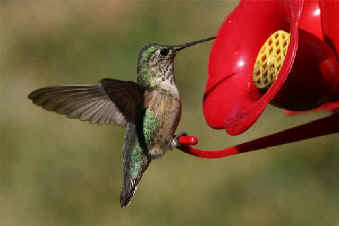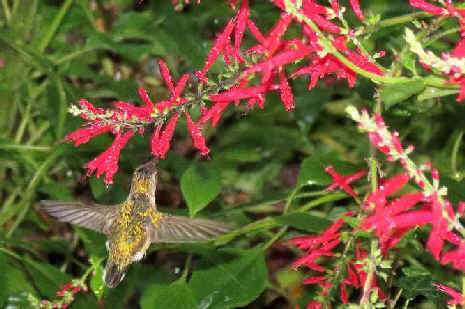 |
PO
Box 9021, Wilmington, DE 19809, USA
E-mail: font@focusonnature.com
Phone: Toll-free in USA 1-888-721-3555
or 302/529-1876
Website:
www.focusonnature.com |
A
List and Photo Gallery
of
Hummingbirds
compiled by Armas Hill
noting those found during
Focus On Nature Tours
throughout the Americas
Part 2 of a List and Photo Gallery
With
some photos courtesy of our tour participants and others.
Our
thanks to those who have contributed!
Link to Part 1 of this List & Photo Gallery of Hummingbirds
And Even More Hummingbird Photos
during the Fall of 2012
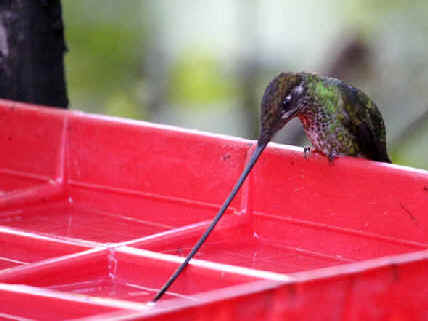
Above
& below: A Sword-billed Hummingbird at a feeder
during the April 2013 Ecuador Tour
(photos by Marie Gardner)
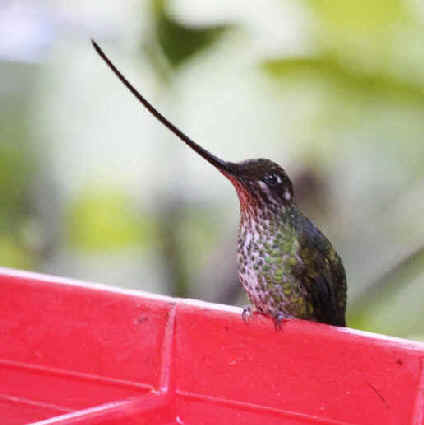
HERE IN THIS PART 2 OF THIS
LIST
LINKS TO THESE HUMMINGBIRD
GROUPINGS:
Amazila: HUMMINGBIRDS &
EMERALDS
AMAZILA includes: Amazilia Hummingbird, Cinnamon Hummingbird,
Rufous-tailed Hummingbird, Escudo Hummingbird, Buff-bellied Hummingbird,
White-bellied Hummingbird, Green-and-white Hummingbird,
Chestnut-bellied Hummingbird, Plain-bellied Emerald,
Versicolored Emerald, Blue-green Emerald, White-chested Emerald,
Andean Emerald, White-bellied Emerald, Azure-crowned Hummingbird,
Violet-crowned Hummingbird, Green-fronted Hummingbird,
Glittering-throated Emerald, Sapphire-spangled Emerald,
Blue-chested Hummingbird, Beryl-crowned Hummingbird,
Purple-chested Hummingbird, Mangrove Hummingbird, Honduran Emerald,
Steely-vented Hummingbird, Indigo-capped Hummingbird,
Snowy-breasted Hummingbird, Blue-tailed Hummingbird,
Berylline Hummingbird, Green-bellied Hummingbird,
Copper-tailed Hummingbird, Copper-rumpted Hummingbird
Microchera: SNOWCAP
Anthocephala: BLOSSOMCROWN
Chalybura: PLUMELETEERS
includes White-vented Plumeleteer,
Ecuadorian Plumeleteer,
Bronze-tailed (formerly Red-footed) Plumeleteer
Lampornis: MOUNTAIN-GEMS
LAMPORNIS
includes Blue-throated Hummingbird
Basilinna: WHITE-EARED HUMMINGBIRD
BASILINNA also includes the Xantu's
Hummingbird
Lamprolaima: GARNET-THROATED HUMMINGBIRD
Adelomyia: SPECKLED HUMMINGBIRD
Phlogophilus: PIEDTAILS
Clytolaema: BRAZILIAN RUBY
Heliodoxa:
BRILLIANTS & JEWELFRONT
Eugenes: MAGNIFICENT HUMMINGBIRD
Hylonympha: SCISSOR-TAILED HUMMINGBIRD
Sternoclypta: VIOLET-CHESTED HUMMINGBIRD
Boissonneaua: CORONETS
Aglaeactis: SUNBEAMS
Urochroa, Oreotrochilus: HILLSTARS
Lafresnaya: VELVETBREAST
Coeligena: INCAS, STARFRONTLETS
Ensiferma: SWORD-BILLED HUMMINGBIRD
Pterophanes: SAPPHIREWING
Patagona: GIANT
HUMMINGBIRD
Dephanoides: FIRECROWNS
Heliangelus: SUNANGELS
Eriocnemis,
Haplophaedia: PUFFLEGS
Urosticte:
WHITETIPS
Ocreatus: RACKET-TAIL
Lesbia: TRAINBEARERS
Sappho,
Polyonymus, Taphrolesbia: COMETS
Ramphomicron,
Chalcostigma: THORNBILLS
Oreonympha:
MOUNTAINEER
Oxypogon:
HELMETCRESTS
Metallura: METALTAILS
Opisthoproba: AVOCETBILL
Aglaiocercus: SYLPHS
Augastes: VISORBEARERS
Schistes: WEDGE-BILLED HUMMINGBIRD
Heliothryx: FAIRIES
Heliactin: HORNED SUNGEM
Loddigesia: MARVELOUS SPATULETAIL
Heliomaster: STARTHROATS
Rhodopis: OASIS HUMMINGBIRD
Thaumastura,
Doricha, Calothorax: SHEARTAILS
CALOTHORAX
includes Lucifer Hummingbird
Tilmatura,
Calliphlox, Microstilbon, Myrtis,
Myrmia, Eulida, Chaetocercus: WOODSTARS
TILMATURA includes
Sparkling-tailed Woodstar
CALLIPHLOX includes Amethyst Woodstar, Bahama Woodstar,
Inaguan Lyretail, Magenta-throated Woodstar, Purple-throated Woodstar
MICROSTILBON includes Slender-tailed Woodstar
MYRTIS includes Purple-collared Woodstar
MYRMIA includes Short-tailed Woodstar
EULIDA includes Chilean Woodstar
CHAETOCERCUS includes White-bellied Woodstar, Little Woodstar,
Gorgeted Woodstar, Esmerladas Woodstar,
Rufous-shafted Woodstar, Santa Maria Woodstar
Mellisuga: VERVAIN
and BEE HUMMINGBIRDS
Archilochus,
Calypte, Atthis,
Selasphorus: HUMMINGBIRDS
ARCHILOCHUS
includes Ruby-throated Hummingbird
and Black-chinned Hummignbird.
CALYPTE includes Anna's Hummingbird, Costa's Hummingbird
SELASPHORUS includes Broad-tailed Hummingbird,
Rufous Hummingbird, Allen's hummingbird, Calliope Hummingbird,
and Volcano Hummingbird, Scintillant Hummingbird
MORE
HUMMINGBIRD GROUPINGS
IN PART 1 OF THIS LIST
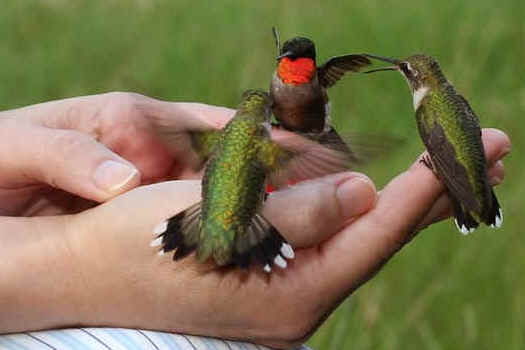
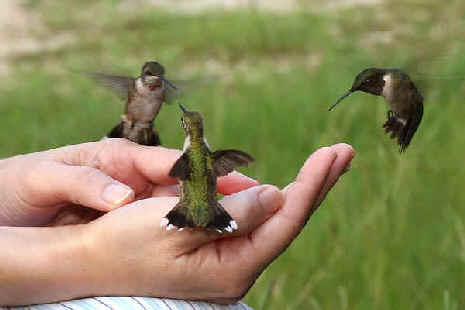
In
the two photos above, Ruby-throated Hummingbirds
(upper)
and Black-chinned
Hummingbirds
(lower)
In photos below, a Blue-tufted Starthroat,
photographed during a FONT tour in Brazil,
and a male Black-chinned Hummingbird,
1 of 14 species of hummingbirds
seen during FONT tours in Arizona.
(Starthroat photo by Andy Smith,
Black-chinned photo by Howard Eskin)
Other Links:
Upcoming FONT Birding & Nature Tours
WITH HUMMINGBIRDS, in:
ARIZONA,
USA
CENTRAL
aMERICA
(mexico, BELIZE. guatemala,
costa rica, panamA)
THE
WEST INDIES
SOUTH
AMERICA (BRAZIL & ECUADOR)
SOUTH
AMERICA (ARGENTINA & CHILE)
LISTS & PHOTO GALLERIES OF BIRDS IN:
North America
Mexico
the Caribbean
Central America Brazil
Chile Ecuador
FOR MORE ABOUT PLANTS REFERRED TO HERE,
THE LINK BELOW GOES TO LISTS AND PHOTO GALLERIES
WITH PLANTS OF THE DESERT, AND THE TROPICS
Desert
Plants of Mexico & the Southwest US
Tropical Plants of
Mexico, Central America, South America,
and Caribbean Islands
Plant Genera
in this FONT Website
HERE'S
A LINK TO CHAD KREMP'S WEBSITE
RELATING TO FLOWERS THAT ATTRACT HUMMINGBIRDS:
www.kremp.com/using-flowers-to-attract-hummingbirds.htm


A
List and Photo Gallery of Hummingbirds
compiled by Armas Hill
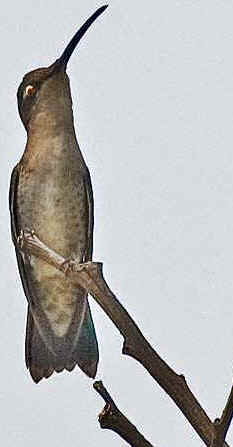 Codes:
Codes:
Places
where Hummingbirds
have been seen during FONT Tours
are noted by an (*)
after the two-letter code.:
AK: Alaska, US
AR: Argentina, South America
AZ: Arizona, US
BL: Bolivia, South America
BR: Brazil, South America
BZ: Belize, Central America
CA: California, US
CH: Chile, South America
CO: Colorado, US
CR: Costa Rica, Central America
DE: Delaware, US
DM: Dominica, West Indies
DR: Dominican Republic, West Indies
EC: Ecuador, South America
FL: Florida, US
GU: Guatemala, Central America
HN: Honduras, Central America
JM: Jamaica, West Indies
MX: Mexico
NC: North Carolina, US
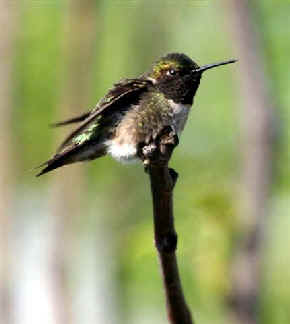 NM: New Mexico, US
NM: New Mexico, US
PG: Paraguay, South America
PN: Panama, Central America
PR: Puerto Rico, West Indies
SL: Saint Lucia, West Indies
SV: Saint Vincent, West Indies
TX: Texas, US
UG: Uruguay, South America
VE: Venezuela, South America
Status of Hummingbirds, as designated by
Birdlife International:
(t): a globally threatened, or rare, species
(t1): critical
(t2): endangered
(t3): vulnerable
(nt): a near-threatened species globally
(nt-dd): possibly near-threatened, but data deficient
John Gould, who lived from 1804 to 1881, described many species and subspecies
of hummingbirds. He was one of the most prolific artists and publishers of
ornithological subjects. Nearly 3,000 lithographs were created during the span
of his work.
In this two-part list, species and subspecies of hummingbirds described by Gould
are noted, and there are illustrations of some of his lithographs, of the
Band-tailed Barbthroat, Sombre Hummingbird, White-tailed Emerald, Brazilian
Ruby, and Black-eared Fairy.
In 2014, a fine new book was published, entitled "Hummingbirds, a
Life-sized Guide to Every Species" by Michael Fogden, Marianne Taylor,
and Sheri Williamson.
Some information has been incorporated here from that book which is highly
recommended.
AMAZILIA
- Amazilia Hummingbird ______ EC(*)
PE
Amazilia amazilia
SUBSPECIES:
Amazilia amazilia amazilia ______ subspecies in
western Peru
Amazilia amazilia caeruleigularis ______
subspecies in southwestern Peru
With a purple throat patch
Amazilia amazilia dumerilii ______ subspecies
in northern Peru and in Ecuador in the western lowlands
Smaller than the nominate and with a white throat patch.
Amazilia amazilia leucophoea ______ subspecies
in northwestern Peru
Smaller than the nominate and with a white throat patch, but with
bronzy-green instead of reddish underparts
What has been until recently an unnamed subspecies of Amazilia amazilia has
been found in Ecuador in southern Azuay (and is in the photograph below,
under "Loja Hummingbird").
The Amazilia Hummingbird feeds on nectar from a variety of
flowering plants, among them those in Erythrina
and Psittacanthus.
(the photo below of Amazilia amazilia dumerilii
by Marie Gardner, along coastal Ecuador, during the FONT tour
there in May 2014)
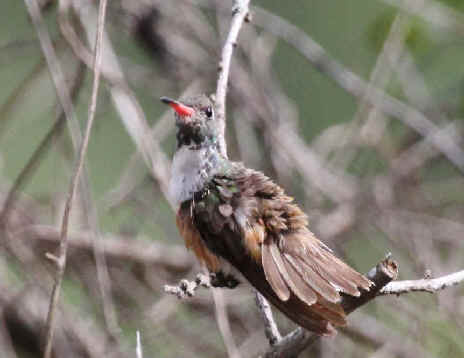
- "Loja Hummingbird" ______ EC(*)
(originally described by Gould in 1860)
Amazilia (amazilia) alticola
Amazilia (amazilia) azuay
The Loja Hummingbird has been considered as part of the Amazilia
Hummingbird (above), and by most authorities it still is.
What has until
recently been considered an undescribed subspecies (noted below) compounds the
story.
Now, that subspecies is Amazilia (amazilia)
azuay, with a whiter belly that other subspecies of the Amazilia
(including the Loja) Hummingbird.
The geographic range of the "Loja Hummingbird", Amazilia
(amazilia) alticola, is in southern
Ecuador.
It has a mostly rufous tail, although the central pair of rectrices are
bronzy green above, sometimes making the tail, when viewed from above,
appear green.
The bird in the photograph below is what was said in "The
Birds of Ecuador" by Robert Ridgely and Paul Greenfield to be an
undescribed race in the southern Azuay province,
Now it is Amazilia (amazilia) azuay.
It is with mainly white underparts, and with rufous confined to limited
amount on the flanks.
It differs from the Amazilia Hummingbird, Amazilia
amazilia, and the Loja Hummingbird, Amazilia
(amazilia) alticola, by is having upper tail coverts mostly rufous, and
seemingly having a less extensive reddish pink bill coloration.
The bird in the photo below was one of a few seen at the same site during
the FONT Tour in southern Ecuador in April 2014.
(photo below, of Amazilia (amazilia) azuay,
by Marie Gardner)
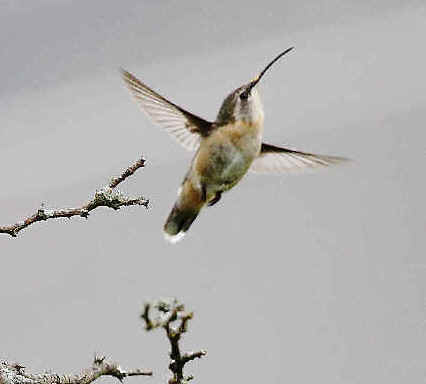
- Cinnamon Hummingbird ______ BZ(*)
CR(*) GU(*) HN(*) MX(*)
Amazilia rutila
SUBSPECIES:
Amazilia rutila corallirostris ______
subspecies from southern Mexico to Costa Rica
Amazilia rutila diluta ______ subspecies in
northwest Mexico
Amazilia rutila graysoni ______ subspecies on
the Tres Marias Islands in western Mexico
Amazilia rutila rutila ______ subspecies in
western Mexico
The Cinnamon Hummingbird feeds on nectar from a variety of trees,
shrubs, vines, epiphytes, cacti, thistles, and mistletoes (in Psittacanthus).
(photo below by Marie Grenouillet)
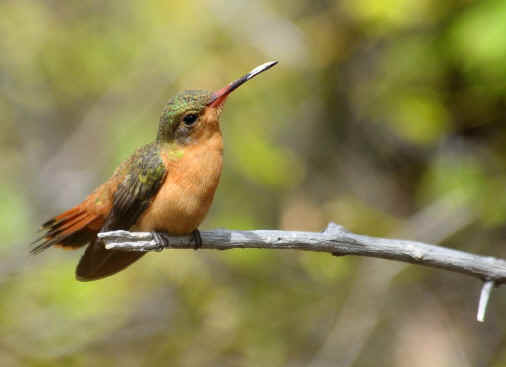
The Cinnamon Hummingbird ranges in lowlands from Sinaloa
and the Yucatan Peninsula in Mexico south to Costa Rica. In the United
States, it has occurred at Patagonia, Arizona July 21 to 23, 1992, and at
Santa Teresa in New Mexico from September 18 to 21, 1993.
- Rufous-tailed Hummingbird ______
BZ(*) CL CR(*) EC(*) GU(*) HN(*) MX(*)
PN(*) VE(*)
Amazilia tzacatl
Another name for Amazilia
tzacati has been the Reiffer's Hummingbird.
SUBSPECIES:
Amazilia tzacati brehmi ______ subspecies
in southwestern Colombia, in Narino, described in 1999
Amazilia tzacati fuscicaaudata ______ subspecies
in northern Colombia and western Venezuela
Amazilia tzacati handleyi ______ subspecies in
northwest Panama on the island Escudo de Veraguas, described in 1963
Amazilia tzacati jucunda ______ subspecies in
western Colombia and western Ecuador
Amazilia tzacati tzacati ______ subspecies from
Mexico to Panama
In Ecuador, the Rufous-tailed Hummingbird occurs mostly
below 4,500 feet above sea level. Locally, or possibly seasonally, it can be
as high as 7,500 feet above sea level.
(first two photos below, of Rufous-tailed Hummingbirds in Central
America)


(Below, a Rufous-tailed Hummingbird photographed during the FONT Ecuador
Tour in April 2013,
the subspecies Amazilia tzacati jucunda,
photo by Marie Gardner)
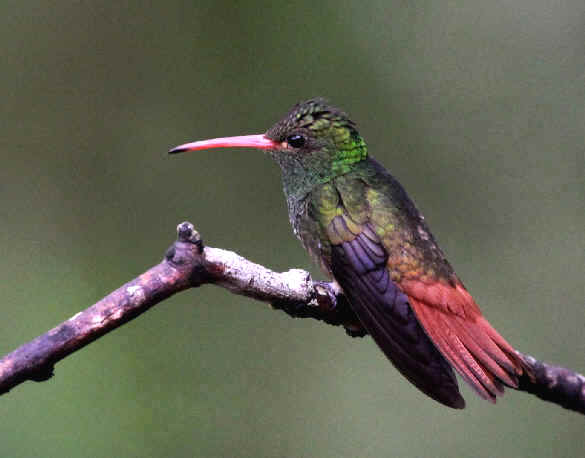
- Escudo Hummingbird (t3) ______
PN
Amazilia handleyi
Amazilia handleyi
has a very small range. It is endemic to Isla Escudo de Veraguas in the
Caribbean Sea, off the coast of Bocas del Toro, in Panama.
It was observed occasionally in March 1958, and 5 specimens were collected
during 5 days in March 1962. More recent surveys have found the species to
be common, but in an extremely small range.
- Buff-bellied Hummingbird ______
BL GU(*) MX(*) TX(*)
Amazilia yucatanensis
SUBSPECIES:
Amazilia yucatanensis cerviniventis ______ subspecies
in eastern Mexico, described by Gould in 1856
Amazilia yucatanensis chalconota ______ subspecies
in northeastern Mexico and southern Texas
Amazilia yucatanensis yucatanensis ______ subspecies
in southeastern Mexico, northern Guatemala, northern Belize
In the United States, the Buff-bellied Hummingbird breeds in south
Texas. After nesting, a small number move northward & eastward along the
US Gulf Coast. Some winter eastward to Florida, occurring there from October
to March. The few winter US records away from the coastal plain of the Gulf
of Mexico include those in central Texas and more rarely in Arkansas,
Mississippi, and Alabama.
- White-bellied Hummingbird ______
AR(*) BL BR
PE
Amazilia chionogaster
SUBSPECIES:
Amazilia chionogaster chionogaster ______ subspecies
in northern and central Peru
Amazilia chionogaster hypoleuca ______
subspecies from southeast Peru to northwest Argentina
The White-bellied Hummingbird is a South American species, not be
confused with a bird in Central America, the White-bellied Emerald, Amazilia
candida.
- Green-and-white Hummingbird ______
PE
Amazilia viridicauda
The geographical range of the Green-and-white Hummingbird is
central Peru.
- Chestnut-bellied Hummingbird (t1)
______ CL (species described by Gould in 1856)
Amazilia castaneiventris
The known geographic range of Amazilia castaneiventris is extremely small,
in the eastern Andes in Colombia.
- Plain-bellied Emerald ______ BR
VE
Amazilia leucogaster
SUBSPECIES:
Amazilia leucogaster bahiae ______ subspecies in
eastern Brazil
Amazilia leucogaster leucogaster ______ subspecies
in eastern Venezuela, the Guianas, northeastern Brazil
- Versicolored Emerald
______ AR(*) BL BR(*)
CL PE PG VE(*)
Amazilia versicolor
SUBSPECIES:
Amazilia versicolor hollandi ______ subspecies
in southeastern Venezuela
Amazilia versicolor kubtchecki ______ subspecies
in southwestern Brazil, northeastern Bolivia, eastern Paraguay, northeastern
Argentina
Amazilia versicolor millerii ______ subspecies in
eastern Colombia, eastern Peru, and northern Brazil
Amazilia versicolor nitidifrons ______ subspecies in northeastern
Brazil, described by Gould in 1860
Amazilia versicolor versicolor ______ subspecies
in southeastern Brazil
It is the concensus of most that what was described as a new species in
1982, Amazila rondiniae, the Rondonia
Emerald, be best treated as a form (or subspecies) of the
Versicolored Emerald, Amazilia versicolor.
- Blue-green Emerald ______ BL
BR (species described
by Ruschi in 1982)
Amazilia rondoniae
The geographic range of the Blue-green Emerald is west-central
Brazil and northern Bolivia.
- White-chested Emerald ______ BR
TT VE(*)
Amazilia brevirostris
SUBSPECIES:
Amazilia brevirostris brevirostris ______ subspecies
in eastern Venezuela and Guyana to north-central Brazil
Amazilia brevirostris chionopectus ______
subspecies in Trinidad, described by Gould in 1859
Amazilia brevirostris orienticola ______ subspecies
in coastal French Guiana
- Andean Emerald ______ CL
EC(*) PE
Amazilia
(or Agyrtria) franciae
SUBSPECIES:
Amazilia franciae viridiceps ______ in Ecuador,
subspecies in the west, nearly endemic to Ecuador
Amazilia franciae franciae ______ in northwest
and central Colombia
Amazilia franciae cyanocollis ______ in Ecuador,
in the southeast - only recently found in Ecuador, first in 1989 and 1992;
known previously only in northern Peru, described by Gould
in 1854
In A. f. cyanocollis
the purple-blue of the cap extends down the back of the head.
Amazilia franciae viridiceps ______ subspecies
in southwest Colombia and western Ecuador; nearly endemic to Ecuador, described by Gould in
1860
A. f. viridiceps has a shorter
tail and green cap.
The medium-length bill of the adult male Andean Emerald has
a black upper mandible and a black-tipped pink lower mandible.
The Andean Emerald is a trapliner, feeding mostly at mid to high
levels, on the nectar of a variety of plants including Musa
(banana), Canna, Psammisia, and Eugenia.
It also catches small insects.
The Andean Emerald is most common at above 3,000 feet above sea
level.
In western Ecuador, it is at mostly below 4,200 feet, while in eastern
Ecuador from 2,700 to 4,800 feet above sea
level.
(upper photo below, by Marie Gardner, during the FONT Ecuador Tour in April
2013,
lower photo below, in Ecuador, by Larry O'Mealie)
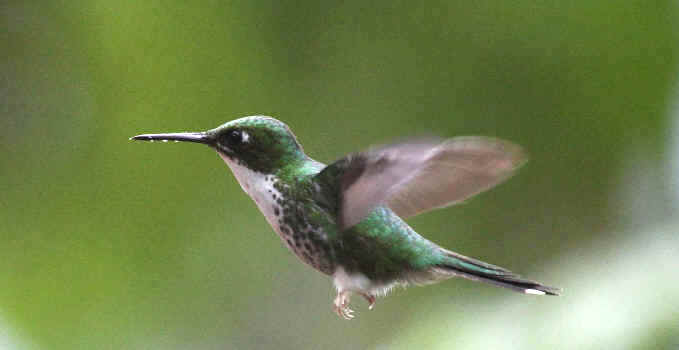
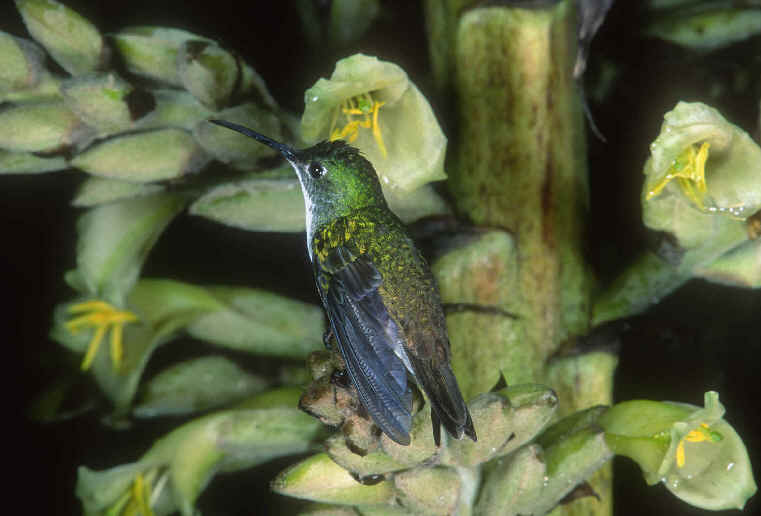
- White-bellied Emerald ______ BZ(*)
GU(*) HN(*) MX(*)
Amazilia candida
SUBSPECIES:
Amazilia candida candida ______ subspecies
from southern Mexico (Chiapas) to Nicaragua
Amazilia candida genini ______ subspecies in
eastern and southern Mexico
Amazilia candida pacifica ______ subspecies in
southeastern Mexico (the Yucatan Peninsula) and nearby Guatemala
- Azure-crowned Hummingbird ______
GU(*) HN(*) (has been called Red-billed
Azurecrown)
Amazilia cyanocephala
SUBSPECIES:
Amazilia cyanocephala chlorostephana ______ subspecies
from eastern Honduras to northeastern Nicaragua
Amazilia cyanocephala cyanocephala ______
subspecies from Mexico to north-central Nicaragua
- Violet-crowned Hummingbird ______
AZ(*) MX (species described by Gould in
1859)
Amazilia violiceps
SUBSPECIES:
Amazilia violiceps ellioti ______ subspecies
from the southwest USA to northwest and central Mexico
Amazilia violiceps violiceps ______ subspecies
in southwest Mexico
(photos below, taken during FONT tours in Arizona,
at a nest and at a feeder.
lower photo by Marie Gardner during the FONT tour in August 2010)

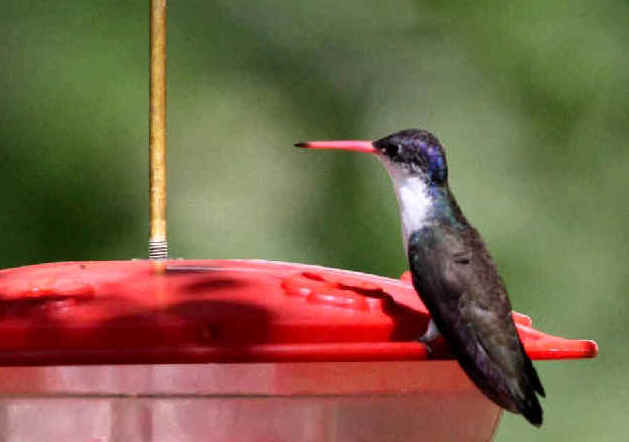
The Violet-crowned Hummingbird is nearly a Mexican endemic, but its northern breeding
range does extend into southeastern Arizona and southwestern New Mexico. In
southeast Arizona, breeding is in the areas of the Sonoita Creek and the
Huachuca & Chiricahua Mountains. A few individuals spend the winter near
feeders in southeast Arizona. But mostly the species moves into Arizona and
New Mexico in June.
It occurs as a vagrant in central Arizona (August, October), in California
(July to December, and March & May), and in west Texas (March, July,
December), southern Texas (May, October), and the upper Texas Gulf Coast
(March).
- Green-fronted Hummingbird ______
MX
Amazilia viridifrons
SUBSPECIES:
Amazilia viridifrons viridifrons ______
subspecies in southern Mexico in Guerrero
Amazilia viridifrons wagneri ______ subspecies
in southern Mexico in Oaxaca and Chiapas
- Glittering-throated Emerald ______
BL BR(*) CL EC(*) PE PG(*) VE(*)
Amazilia
(or Polyerata) fimbriata
SUBSPECIES:
Amazilia fimbriata apicalis ______ subspecies in
eastern Colombia, described by Gould in 1861
Amazilia fimbriata elegantissima ______ subspecies
in northeastern Colombia and northwestern and northern Venezuela
Amazilia fimbriata fimbriata ______ subspecies
in northeastern Venezuela, the Guianas, northern Brazil
Amazilia fimbriata fluviatilus ______ subspecies
in southeastern Colombia, eastern Ecuador, described by
Gould in 1861
Amazilia fimbriata laeta ______ subspecies in
northeastern Peru
Amazilia fimbriata nigricauda ______ subspecies
from central Brazil to eastern Bolivia
Amazilia fimbriata tephrocephala ______
subspecies from southeastern Brazil to eastern Paraguay
In Ecuador, the Glittering-throated Emerald occurs up to 3,600
feet above sea level.
(photo below by Marie Gardner, during the FONT tour in southern Ecuador in
April 2014)
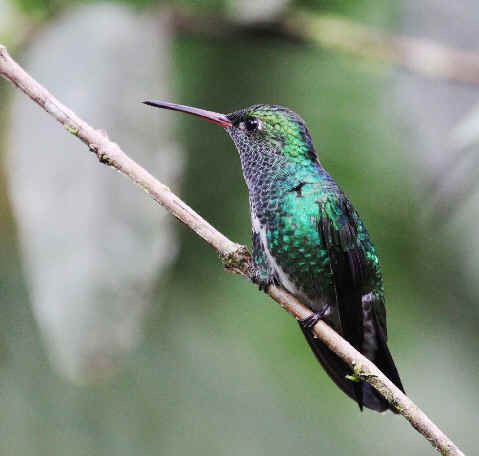
- Sapphire-spangled Emerald ______
BL BR(*) PE VE
Amazilia
(or Polyerata) lactea
SUBSPECIES:
Amazilia lactea bartletti ______ subspecies in
eastern and southeastern Peru, and northern Bolivia, described by Gould in
1866
Amazilia lactea lactea ______ subspecies in
central and southern Brazil
Amazilia lactea zimmeri ______ subspecies in
southeastern Venezuela, described in 1941
There has been said to be one sighting of a Sapphire-spangled Emerald
in eastern Ecuador.
- Blue-chested Hummingbird ______
CR(*) EC(*) PN(*) (species
described by Gould in 1853)
Amazilia
(or Polyerata) amabilis
The geographic range of the Blue-chested Hummingbird is from
Nicaragua to Ecuador.
In Ecuador, the Blue-chested Hummingbird occurs mostly below
900 feet above sea level.
- Beryl-crowned Hummingbird
______ CR(*) PN(*) (has been
considered part of the Blue-chested Hummingbird)
Amazilia decora
Another name for Amazilia decora is
the Charming Hummingbird.
The geographic range of the Beryl-crowned Hummingbird is in
southwestern Costa Rica and eastern Panama, on the Pacific slope.
- Purple-chested Hummingbird ______
CL EC
Amazilia rosenbergi
The geographic range of the Purple-chested Hummingbird is western
Colombia and northwestern Ecuador.
In Ecuador, the Purple-chested Hummingbird occurs mostly below
1,800 feet above se level.
- Mangrove Hummingbird (t2) ______ CR(*)
Amazilia boucardi
The geographic range of the Mangrove Hummingbird is western Costa
Rica.
It is 1 of only 4 species endemic to Costa Rica.
- Honduran Emerald (t1) ______
HN
Amazilia luciae
The Honduran Emerald is endemic to Honduras. It is the only
species endemic to Honduras.
- Steely-vented Hummingbird ______
CL CR(*) VE(*)
Amazilia saucerrottei
SUBSPECIES:
Amazilia saucerrottei braccta ______ subspecies
in the Andes in Merida, Venezuela
Amazilia saucerrottei hoffmanni ______
subspecies from southwest Nicaragua to central Costa Rica
Amazilia saucerrottei saucerrottei ______ subspecies
on Andean slopes and valleys in northwest Colombia
Amazilia saucerrottei warscewiczi ______ subspecies
in northern and central Colombia
- Indigo-capped Hummingbird ______
CL
Amazilia cyanifrons
The geographic range of the Indigo-capped Hummingbird is northern
and central Colombia.
- Snowy-breasted Hummingbird ______
CR(*) PN(*) (also called Snowy-bellied
Hummingbird)
Amazilia edward
SUBSPECIES:
Amazilia edward collata ______ subspecies in
east-central Panama, described in 1952
Amazilia edward edward ______ subspecies in
west-central Panama
Amazilia edward margaritarum ______ subspecies
in eastern Panama and on offshore islands in the Gulf of Panama
Amazilia edward niveoventer ______ subspecies in
southwestern Costa Rica and western and central Panama and Coiba Island, described by Gould in
1851
(photo below, by Marie Grenouillet)
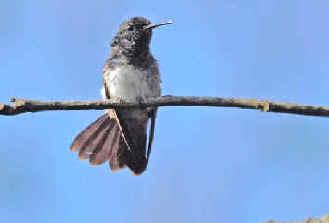
- Blue-tailed Hummingbird ______ CR
GU(*) HN MX
(species described by Gould in 1859)
Amazilia cyanura
SUBSPECIES:
Amazilia cyanura cyanura ______ subspecies in
southern Honduras and northern Nicaragua
Amazilia cyanura guatemalae ______ subspecies in
southern Mexico and Guatemala
A. c. guatemalae differs from the nominate by having a dark
and more violet rump
Amazilia cyanura impatiens ______ subspecies in
northwest and central Costa Rica
A. c. impatiens
has a more extensive chestnut wing patch
The two more northerly subspecies are quite common over most of their range.
But A. c. impatiens has not been
reliably observed in its small known range since the 1950s and may be
extinct.
The Blue-tailed Hummingbird is found mainly at altitudes of 3,300
feet or lower, but the subspecies A. c.
guatemalae ranges to higher altitudes.
The Blue-tailed Hummingbird is especially fond of Inga flowers, and
it is an agile flycatcher.
- Berylline Hummingbird ______ AZ(*)
GU(*)
HN(*) MX(*)
Amazilia beryllina
SUBSPECIES:
Amazilia beryllina beryllina ______
subspecies in central Mexico
A. b. beryllina
has a green lower back.
Amazilia beryllina devillei ______ subspecies
from southern Guatemala to central Honduras
A. b. devillei has a rich
chestnut-copper color in the back and rump..
Amazilia beryllina lichtensteini ______
subspecies in southern Mexico, in western Chiapas, described in 1950
In A. b. lichtensteini,
the green areas are paler.
Amazilia beryllina sumichrasti ______ subspecies
in southern Mexico, in central and southern Chiapas
A. b. sumichrasti has a violet tinge to the rump and
tail.
Amazilia beryllina viola ______ subspecies in
northwestern and western Mexico
A. b. viola has a gray tinge to the back and rump. In the far
north of its range, the Berylline Hummingbird, A.
b. viola, is migratory.
The Berylline Hummingbird is, as noted above, a mostly
northern Central American species, in Mexico and south to Honduras.
In the United States, it is a very rare summer visitor in the mountains of
southeast Arizona, where it has rarely bred. It also occurs rarely in
southwestern New Mexico (in the Guadalupe Canyon) and in west Texas (in the
Big Bend National Park & in the Davis
Mountains).
- Green-bellied Hummingbird ______
BR CL VE
Amazilia viridigaster
SUBSPECIES:
Amazilia viridigaster iodura ______ subspecies
in northeastern Colombia, western Venezuela, and far-northern Brazil
Amazilia viridigaster viridigaster ______
subspecies in north-central Colombia
- Copper-tailed Hummingbird ______
BR VE
Amazilia cupreicauda
SUBSPECIES:
Amazilia cupreicauda cupreicauda ______
subspecies in eastern Venezuela, Guyana, northern Brazil
Amazilia cupreicauda duidae ______ subspecies in
southern and central Venezuela
Amazilia cupreicauda laireti ______ (subspecies
in far-southern Venezuela) (subspecies described in 1988)
Amazilia cupreicauda pacaraimae ______
(subspecies in southeast Venezuela in Urutani) (subspecies described
in 2000)
- Copper-rumped Hummingbird ______
VE(*)
Amazilia tobaci
SUBSPECIES:
Amazilia tobaci aliciae ______ subspecies in
northeast Venezuela, and Margarita Is.
Amazilia tobaci caudata ______ subspecies in
northeast Venezuela, subspecies described in 1949
Amazilia tobaci caurensis ______ subspecies in
eastern and southeastern Venezuela
Amazilia tobaci erythronotos ______ subspecies
on Trinidad
Amazilia tobaci feliciae ______ subspecies in
north-central Venezuela
Amazilia tobaci monticola ______ subspecies in
northwest Venezuela
Amazilia tobaci tobaci ______ subspecies on
Tobago
(two photos below, by Leroy Tabb, of Amazilia
tobaci erythronotos)
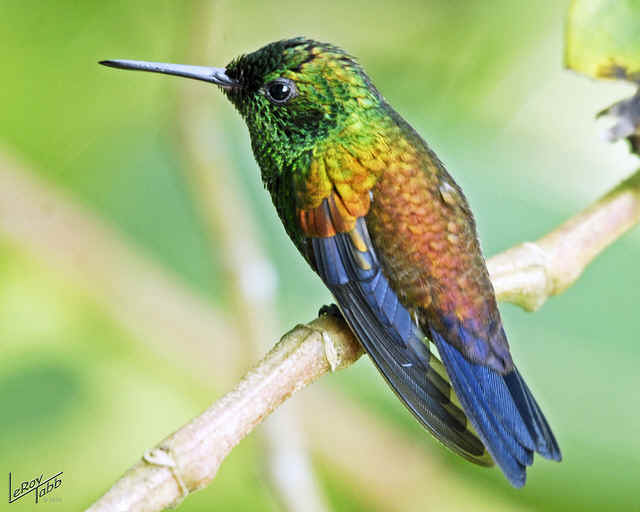
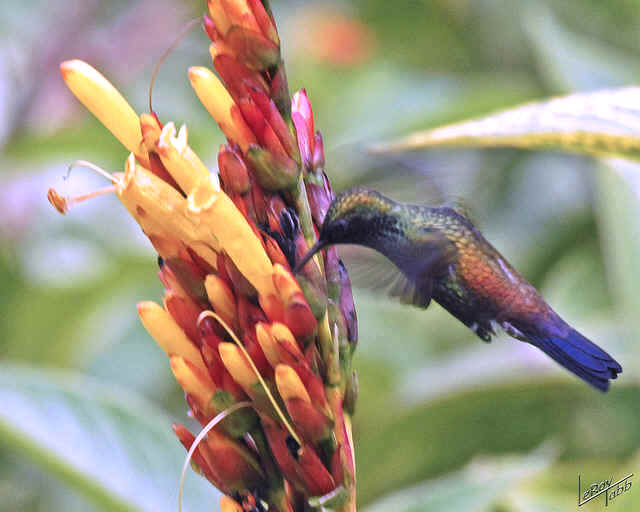
MICROCHERA
- Snowcap ______ CR(*)
Microchera albocoronata
SUBSPECIES:
Microchera albocoronata albocoronata ______
subspecies in west-central Panama, on both slope
Microchera albocoronata parvirostris ______
subspecies from southern Honduras to far-west Panama, on the Caribbean slope
The male of M. a. parvirostris
has a red rather than black underside.
The Snowcap is a tiny hummingbird, 2.5 inches in length. The male is
one of the most distinctive and beautiful of all hummingbirds. Its plumage
is a deep vivid reddish purple above, with a black or red underside. It has
black wings, but contrastingly the adult male has a pure white cap, hence
the bird's name, Snowcap.
The Snowcap feeds on various small flowers, usually traplining.
Males sing at communal leks, up to 6 birds. After mating the female
constructs a tiny cup nest from tree-fern scales.
During FONT tours in Costa Rica, we've truly enjoyed seeing the Snowcap.
(photo below of an adult male Snowcap, by Larry O''Meallie)
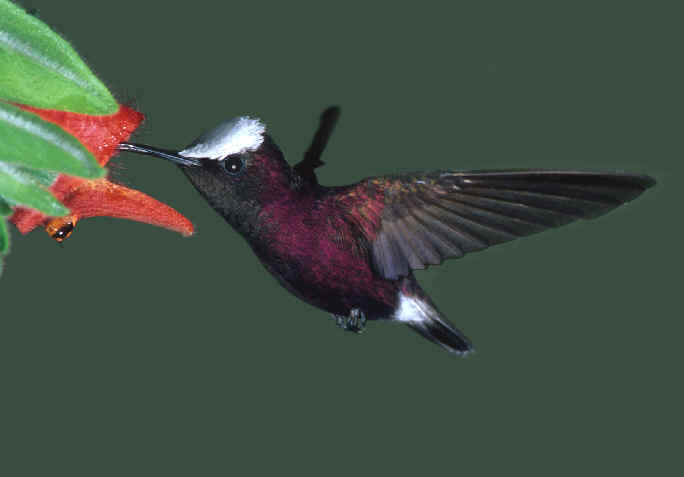
ANTHOCEPHALA
- Blossomcrown (t3) ______ (species
described by Gould in 1854)
Anthocephala floriceps
SUBSPECIES:
Anthocephala floriceps berlepschi ______
(subspecies in central Colombia)
Anthocephala floriceps floriceps ______
(subspecies in northeastern Colombia)
CHALYBURA
- White-vented Plumeleteer ______
PN(*) VE(*)
Chalybura buffonii
SUBSPECIES:
Chalybura buffonii aeneicauda ______ subspecies
in northern Colombia and western and north-central Venezuela
Chalybura buffonii buffonii ______ subspecies in
central and northeastern Colombia and northwestern Venezuela
Chalybura buffonii caeruleogaster ______
subspecies in northern and central Colombia, described
by Gould in 1847
Chalybura buffonii micans ______ subspecies
central and eastern Panama and western Colombia
- Ecuadorian Plumeleteer (ph) ______ EC(*)
Chalybura intermedia
The geographic range of Chalybura intermedia is widely disjunct
from that of Chalybura buffonii,
the White-vented Plumeleteer (above).
Chalybura intermedia also has a different elevational range. It is
not found in the tropical zone as is Chalybura buffonii.
As to plumage differences, Chalybura intermedia has a reddish lower
mandible and pinkish-gray feet, while both are black in Chalybura
buffonii.
Chalybura intermedia is nearly endemic to southwest Ecuador. It has
recently been found in adjacent Tumbes, Peru.
Based on the large number of specimens taken in the 19th and early 20th
Century, and the relative scarceness of recent sightings, it seems that
Chalybura intermedia has declined substantially.
The Ecuadorian Plumeleteer occurs mostly from 1,500 to 5,250 feet
above sea level.
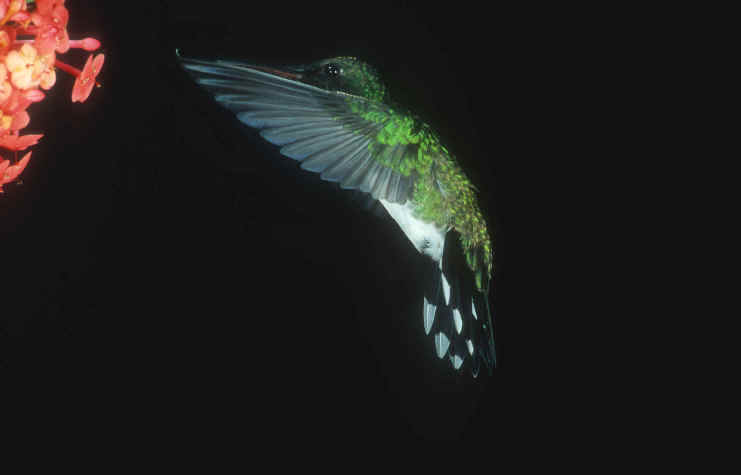
Ecuadorian Plumeleteer
(photo by Larry O'Mealie)
- Bronze-tailed Plumeleteer ______
CR(*) EC PN(*) (has been called Red-footed
Plumeleteer)
Chalybura urochrysia
SUBSPECIES:
Chalybura urochrysia isaurae ______ subspecies
in eastern Panama and northwestern Colombia, described
by Gould in 1861
Chalybura urochrysia melanorrhoa ______ subspecies
in Nicaragua and Costa Rica
Chalybura urochrysia urochrysia ______ subspecies
in southeastern Panama, north-central and western Colombia, northwestern
Ecuador, described by Gould in 1861
In Ecuador (where it is only in the far-northwest), the Bronze-tailed
Plumeleteer occurs up 2,400 feet above sea level.
LAMPORNIS
- Blue-throated Hummingbird (or Mountaingem) ______ AZ(*)
CR(*) MX(*)
Lampornis clemenciae
SUBSPECIES:
Lampornis clemenciae bessophilus ______
(subspecies in the southwestern US and northwestern Mexico)
Lampornis clemenciae clemenciae ______
(subspecies in the southern US, and northeastern, southern, and central
Mexico)
Lampornis clemenciae phasmorus ______ (subspecies
in Texas, in the Chisos Mountains) (subspecies described in 1974)
(photo below)
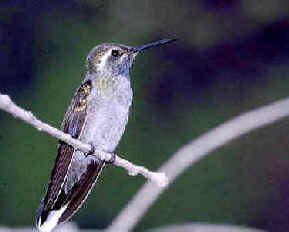
North of Mexico, the Blue-throated Hummingbird, or Blue-throated
Mountaingem, is primarily a "sky island"
mountain species in western Texas, southern New Mexico, and southeastern
Arizona. It has occurred as a a vagrant to central Arizona, central New
Mexico, Colorado (July to August), and in parts of Texas (mostly in the
fall): the Edwards Plateau, the Gulf Coast, the lower Rio Grande Valley, and
the Panhandle. Vagrants have also been in: California (in the summer),
Louisiana (during fall & spring), North Dakota (in June), South Carolina
(in August), and in Utah (in August).
- White-bellied Mountaingem ______
CR(*)
Lampornis hemileucus
The geographic range of the White-bellied Mountaingem is from
north-central Costa Rica to western Panama.
- Purple-throated Mountaingem ______
CR(*)
Lampornis calolaemus
SUBSPECIES:
Lampornis calolaemus calolaemus ______
(subspecies in central Costa Rica)
Lampornis calolaemus homogenes ______ (subspecies
in southern Costa Rica & western Panama) (subspecies described in
1967)
Lampornis calolaemus pectoralis ______ (subspecies
from southern Nicaragua to north-central Costa Rica)
- Gray-tailed Mountaingem ______ CR(*)
Lampornis cinereicauda
The geographic range of the Gray-tailed Mountaingem is
in southern Costa Rica. It is 1 of 4 bird species endemic to the country,
and 1 of 3 species of hummingbirds that are endemic.
(photo below, courtesy of Ruben
Campos)
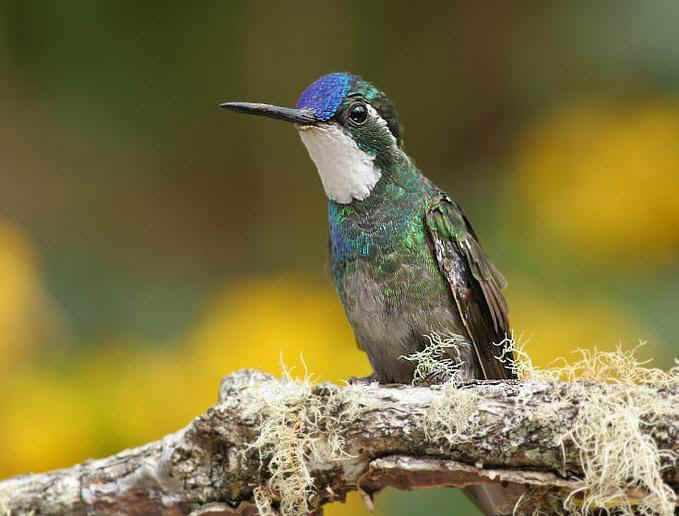
- White-throated Mountaingem
______ PN(*) (said to be conspecific with the Gray-tailed
Mountaingem,
Lampornis cinereicauda)
(species described by Gould in 1851)
Lampornis castaneoventris
The geographic range of the White-throated Mountaingem is in
western Panama.
- Green-throated Mountaingem ______
GU(*) HN(*)
Lampornis viridipallens
SUBSPECIES:
Lampornis viridipallens amadoni ______
(subspecies in southern Mexico) (subspecies described in1968)
Lampornis viridipallens nubivagus ______
(subspecies in El Salvador)
Lampornis viridipallens ovandensis ______
(subspecies in southern Mexico, northwestern Guatemala)
Lampornis viridipallens viridipallens ______ (subspecies
in Guatemala, northern El Salvador, western
Honduras)
- Green-breasted Mountaingem ______
Lampornis sybillae
The geographic range of the Green-breasted Mountaingem is in eastern
Honduras and north-central Nicaragua.
- Amethyst-throated Hummingbird ______
GU(*) MX(*)
Lampornis amethystinus
SUBSPECIES:
Lampornis amethystinus amethystinus ______ (subspecies
in western, central, & eastern Mexico)
Lampornis amethystinus circumventris ______ (subspecies
in southern Mexico) (subspecies described in 1966)
Lampornis amethystinus margaritae ______
(subspecies in southwestern Mexico)
Lampornis amethystinus nobilis ______ (subspecies
in Honduras)
Lampornis amethystinus salvini ______ (subspecies
in southern Mexico, Guatemala, El Salvador)
BASILINNA
- White-eared Hummingbird ______ AZ(*)
GU(*) HN(*) MX(*)
Basilinna leucotis
SUBSPECIES:
Basilinna leucotis borealis ______ (subspecies
in northern Mexico & into southeastern Arizona)
Basilinna leucotis leucotis ______ (subspecies in
central & southern Mexico and Guatemala)
Basilinna leucotis pygmaea ______ (subspecies in
El Salvador, Honduras, El Salvador)
(photo below, taken during a FONT tour)
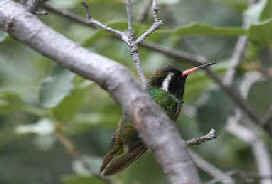
North of Mexico and northern Central America,
the White-eared Hummingbird occurs mostly
in southeastern Arizona, in the Huachuca and Chiricahua Mountains. It has
bred in southern Arizona. Generally it arrives in Arizona in mid-April to
May, and departs August to October.
It also occurs as rarity, from June to October, in southwestern &
north-central New Mexico, and in western & central Texas, including in
the Davis, Guadeloupe, and Chisos Mountains. Most records north & east
of the breeding range are from late-June to August. There is evidence of
some post-breeding movement.
A female that wintered in coastal Mississippi, from November 1995 to January
1996, was extraordinary.
- Xantu's Hummingbird ______ British
Colombia, Canada(*)
Basilinna xantusii
The geographic range of the Xantu's Hummingbird is normally in
southern Baja California, Mexico. The bird referred to below was an
unprecedented vagrant, for whatever reason.
In southern Baja California, the normal range of the Xantu's Hummingbird,
it is generally sedentary, or at most a short-distance migrant. However, it
has occurred as a vagrant in southern California in the US, and oddly, as
noted here, in southwestern British Columbia, Canada.
In California, a male was found, not near a feeder, in eastern San Diego
County in December 1986.The following year, a female was present from
January to March in a yard in Ventura, California, where she nested
unsuccessfully.
In British Columbia, a female took up residence at a feeder in Gibsons from
November 1997 to September 1998. There has not been a satisfactory
explanation of that extraordinary
record.
(photo below of an out-of-range Xantu's Hummingbird in British Colombia,
Canada,
in September 1998, during a FONT Pacific Coast Tour;
normally the species occurs only in Baja California,
Mexico)
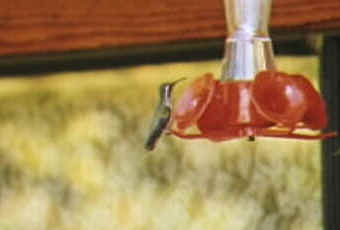
LAMPROLAIMA
- Garnet-throated Hummingbird ______
GU(*)
Lamprolaima rhami
The geographic range of the Garnet-throated Hummingbird is from
central & southern Mexico to Honduras and El Salvador.
The Garnet-throated Hummingbird feeds from flowering shrubs and trees
such as Inga and
Erythrina at low and medium heights.
It nests at the lower end of its altitudinal range. After breeding, the
birds move to higher altitudes.
ADELOMYIA
- Speckled Hummingbird ______ EC(*)
VE(*)
Adelomyia melanogenys (the single member of its genus)
SUBSPECIES:
Adelomyia melanogemys aeneosticta (subspecies in
central & northern Venezuela)
Adelomyia melanogemys cervina (subspecies in western
& central Colombia) (subspecies described by Gould in 1872)
Adelomyia melanogemys chlorospila (subspecies in
southeast Peru) (subspecies described by Gould in 1872)
Adelomyia melanogemys connectens (subspecies in
southern Colombia) (subspecies described in 1945)
Adelomyia melanogemys debellardiana (subspecies in
western Venezuela, in the Perija Mountains) (subspecies described in
1994)
Adelomyia melanogemys inornata (subspecies in Bolivia
& northwest Argentina) (subspecies described by Gould in 1846)
Adelomyia melanogemys maculata ______
(subspecies in Ecuador & northern Peru; in
Ecuador, on the west slope of the Andes)
Adelomyia melanogenys melanogenys ______ (subspecies
from western Venezuela & eastern Colombia to south-central Peru; in
Ecuador, on the east slope of the Andes)
(photo below, by Marie Gardner, during the FONT Ecuador Tour in April 2013)

PHLOGOPHILUS
- Ecuadorian Piedtail (t3) ______
EC (species described by Gould in 1860)
Phlogophilus hemileucurus
The geographic range of the Ecuadorian Piedtail is from southern
Colombia to northeastern Peru.
The status of the Ecuadorian Piedtail was changed in 2012 from near-threatened
to vulnerable, due to a high amount of deforestation in its range and
habitat.
- Peruvian Piedtail (nt) ______
Phlogophilus harterti
The geographic range of the Peruvian Piedtail is in central and
southeastern Peru.
CLYTOLAEMA
- Brazilian Ruby ______ BR(*)
Clytolaema rubricauda
The geographic range of the Brazilian Ruby is in southeastern
Brazil.
(Illustration below, with a female Brazilian Ruby above, and a male
below)
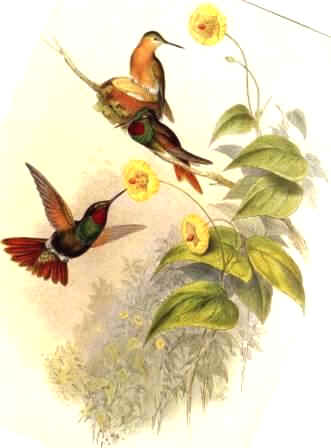
HELIODOXA
- Green-crowned Brilliant ______ CR(*)
EC(*)
Heliodoxa jacula
SUBSPECIES:
Heliodoxa jacula henryi ______ (subspecies in
Costa Rica & western Panama)
Heliodoxa jacula jacula ______ (subspecies in
eastern Panama and northern & central Colombia)
Heliodoxa jacula jamesoni ______ (subspecies
in Ecuador that is geographically isolated from the others, and is nearly
endemic to Ecuador; recorded for the first time in adjacent Narino, in
southwestern Colombia
in 1994)
In Ecuador, the Green-crowned Brilliant occurs mostly from 1,500
to 4,650 feet above sea level.
(photos below: the upper photo in Costa Rica; the lower photo in Ecuador,
upper photo courtesy of Larry O'Meallie,
the lower photo of the bird in Ecuador noted above as being geographically
isolated from the other subspecies,
lower photo by Marie Gardner during the FONT Ecuador Tour in April
2014)
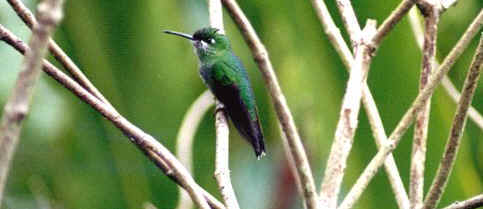
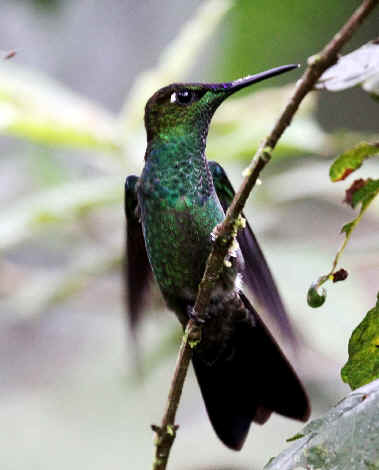
- Velvet-browed Brilliant ______
BR VE(*)
Heliodoxa xanthogonys
SUBSPECIES:
Heliodoxa xanthogonys willardi ______ (subspecies
in extreme southern Venezuela) (subspecies described in 2001)
Heliodoxa xanthogonys xanthogonys ______
(subspecies in eastern Venezuela, Guyana, north-central Brazil)
- Pink-throated Brilliant (t3) ______
BR EC (species described by Gould in 1860)
Heliodoxa gularis
The geographic range of the Pink-throated Brilliant is in
southern Colombia, northeastern Ecuador, northeastern Peru, and northwestern
Brazil.
- Rufous-webbed Brilliant ______
Heliodoxa branickii
The geographic range of the Rufous-webbed Brilliant is in
southeastern Peru & northeaster Bolivia.
- Black-throated Brilliant ______
BR EC
Heliodoxa schreibersii
SUBSPECIES:
Heliodoxa schreibersii schreibersii ______ (subspecies
from southeast Colombia to northeast Peru & northwest Brazil)
Heliodoxa schreibersii whitelyana ______
(subspecies in eastern Peru) (subspecies described by Gould in 1872)
- Fawn-breasted Brilliant ______ EC(*)
Heliodoxa rubinoides
SUBSPECIES:
Heliodoxa rubinoides aequatorialis ______ (in
Ecuador, subspecies in the west)
Heliodoxa rubinoides cervinigularis ______ (in
Ecuador, subspecies in the east)
The Fawn-breasted Brilliant feeds on the nectar of many different
plants, including species of Heliconia in the understory and Inga
and Erythrina higher up. It also takes small insects.
In Ecuador, the Fawn-breasted Brilliant occurs mostly from 3,300 to
6,300 feet above sea level.
- Empress Brilliant (nt) ______ EC(*)
(species described by Gould in 1856)
Heliodoxa imperatis
The geographic range of the Empress Brilliant is in Colombia
& northwest Ecuador, on the west slope of the Andes.
In Ecuador, the Empress Brilliant occurs mostly from 4,500 to 6,300
feet above sea level.
(photograph below: an of Empress Brilliant in western Ecuador, courtesy
of Larry O'Meallie)
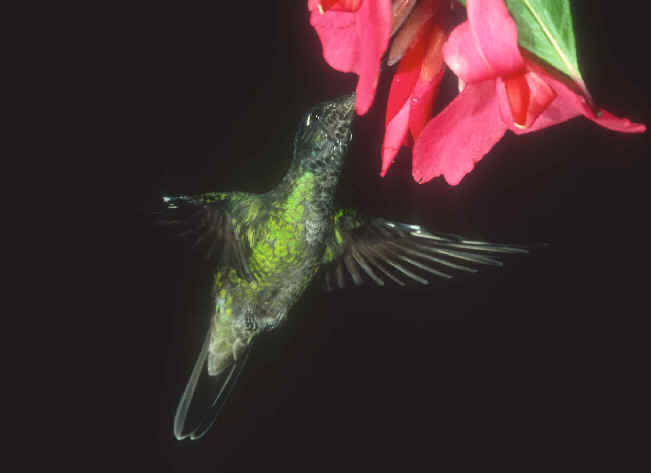
- Violet-fronted Brilliant ______
EC(*) VE(*)
Heliodoxa leadbeateri
SUBSPECIES:
Heliodoxa leadbeateri leadbeateri ______ (subspecies
in northern Venezuela)
Heliodoxa leadbeateri otero ______ (subspecies in
central & southern Peru and northwestern Bolivia)
Heliodoxa leadbeateri parvula ______ (subspecies
in northwestern Venezuela and in Colombia)
Heliodoxa leadbeateri sagitta ______ (subspecies
in eastern Ecuador & northern Peru)
- Gould's Jewelfront ______ BR
EC(*)
(species described by Gould in 1846)
Heliodoxa
(formerly Polyplancta) aurescens
The geographic range of the Gould's Jewelfront is in Amazonia.
EUGENES
- Magnificent
Hummingbird ______ AZ(*) CR(*) GU(*)
MX(*) PN(*)
Eugenes fulgens
(the single member of its
genus)
SUBSPECIES:
Eugenes fulgens fulgens Rivoli's
Hummingbird ______ AZ(*) GU(*) MX(*)
(subspecies from the southwest US to Nicaragua)
Eugenes fulgens spectabilis
______ CR(*) PN(*) (subspecies
in Costa Rica & western Panama)
(Photos below;
the upper photo by Virginia Woodhouse during a FONT tour in Costa Rica
in March 2012
the middle photo courtesy of Larry O'Meallie; the lower photo taken in Costa Rica)
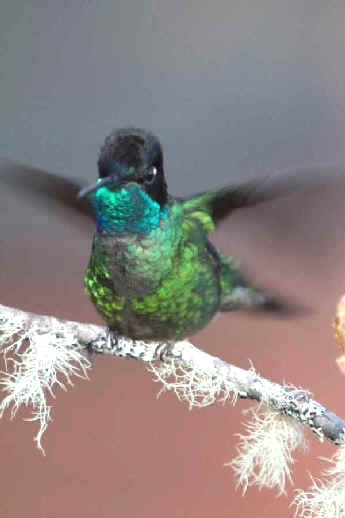

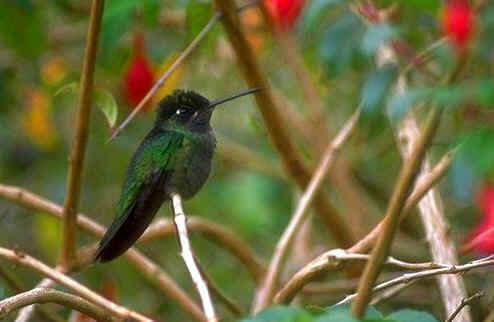
North of Mexico and Central America, the Magnificent
Hummingbird is primarily a
"sky island" mountain species in western Texas, southern New
Mexico, and southeastern Arizona.
Young males are often highly nomadic, Banded birds have traveled hundreds of
miles between mountain ranges during a season. Such migration is through
lower elevations, especially foothills, in the spring and fall.
Away from the US breeding range, there have been occurrences in Colorado
(from May to October), and less so in: Alabama (September to February),
Arkansas (in July), California (in April), Georgia (in the winter),
Minnesota (in July), Nevada (in June), Utah (in July), Wyoming (in June
& July), and in southern Texas (in September).
HYLONYMPHIA
- Scissor-tailed Hummingbird (t3)
______ (species described by Gould in 1873)
Hylonymphia macrocerca
The geographic range of the Scissor-tailed Hummingbird is in
northeastern Venezuela on the Paria Peninsula.
STERNOCLYTA
- Violet-chested Hummingbird
______ VE(*) (species described by Gould in 1846)
Sternoclyta cyanopectus
The geographic range of the Violet-chested Hummingbird is in
northwestern Venezuela.
BOISSONNEAUA
- Buff-tailed Coronet ______ EC(*)
Boissonneaua flavescens
SUBSPECIES:
Boissonneaua flavescens flavescens ______ (subspecies
in western Venezuela, and Colombia and Ecuador on the east slope of the Andes)
Boissonneaua flavescens tinochlora ______ (subspecies
in Colombia and Ecuador on the west slope of the Andes)
In Ecuador, the Buff-tailed Coronet occurs mostly from 4,500 to 7,200
feet above sea level.
(upper photo below by Marie Gardner during the FONT tour in Ecuador in April
2013,
the lower photo below of an immature Buff-tailed Coronet in Ecuador by
Larry O'Mealie)
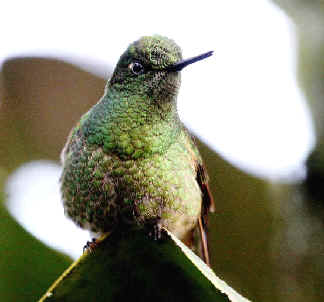
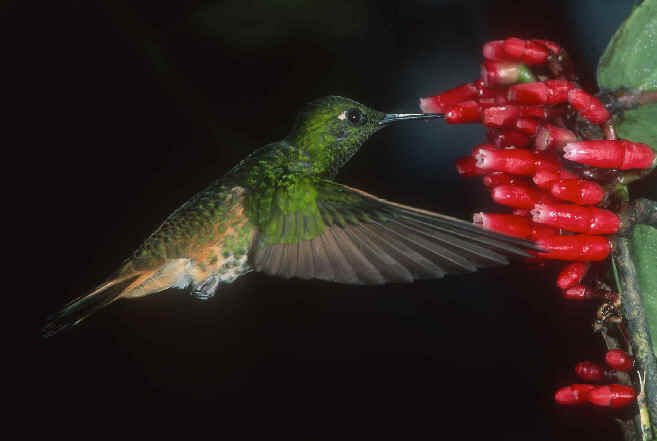
- Chestnut-breasted Coronet ______
EC(*)
Boissonneaua matthewsii
The geographic range of Chestnut-breasted Coronet is in
southeastern Colombia, Ecuador, and Peru.
In Ecuador, the Chestnut-breasted Coronet occurs mostly from 5,700 to
8,100 feet above sea level.
(photo below by Marie Gardner during the FONT tour in Ecuador in April
2013)

(another photo, below, was by Marie Gardner during the FONT tour in Ecuador in April
2014)
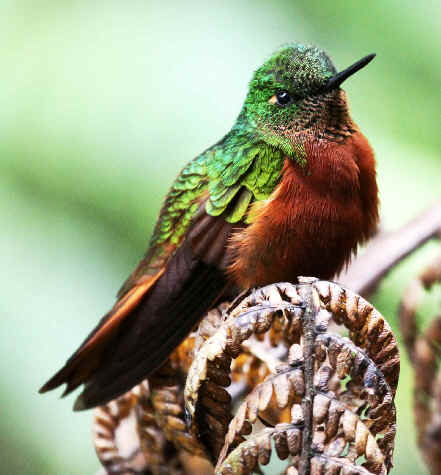
- Velvet-purple Coronet (nt)
______ EC(*)
Boissonneaua jardini
The geographic range of the Velvet-purple Coronet is in
southwestern Colombia & northwestern Ecuador.
In Ecuador, the Velvet-purple Coronet occurs mostly from 2,400 to
5,100 feet above sea level.
(photo below by Marie Gardner during the FONT tour in Ecuador in April
2013)
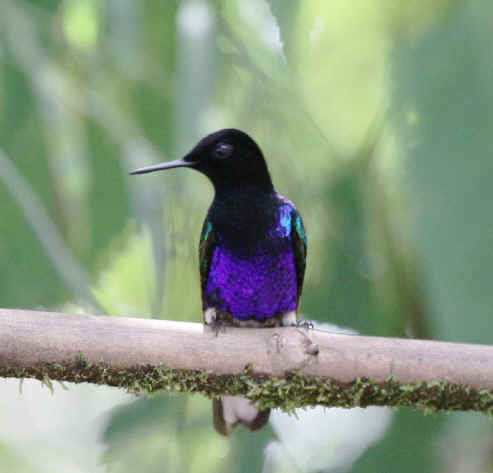
AGLAEACTIS
- Shining Sunbeam ______ EC(*)
Aglaeactis cupripennis
SUBSPECIES:
Aglaeactis cupripennis caumatonota ______ (subspecies
in central & southern Peru) (subspecies described by Gould in
1848)
Aglaeactis cupripennis cupripenni ______
(subspecies from Colombia to northern Peru; the subspecies in most of the species' range in Ecuador)
Aglaeactis cupripennis parvulus ______
(subspecies in southern Ecuador in areas of Azuay, El Oro, Loja, and
Zamora-Chinchipe)
In Ecuador, the Shining Sunbeam occurs mostly from
8,400 to 10,800 feet above sea level.
(upper photo below, courtesy of Larry O'Meallie,
lower photo by Marie Gardner during the FONT tour in Ecuador in April
2013,
during that tour Shining Sunbeams were seen at a nest.)
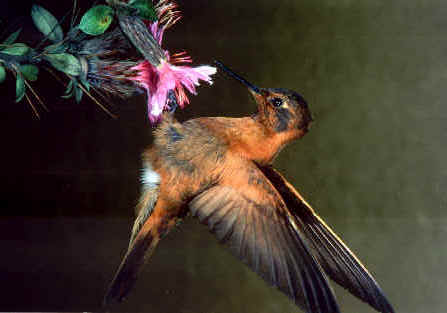
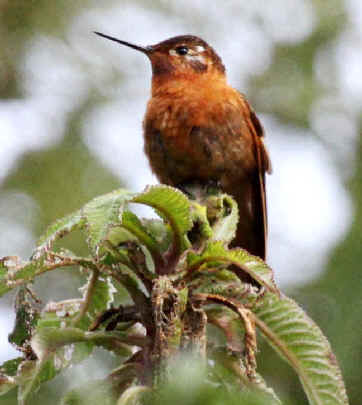
- Purple-backed Sunbeam (t3) ______
Aglaeactis aliciae
The geographic range of the Purple-backed Sunbeam is in
northern Peru in the Maranon Valley.
- White-tufted Sunbeam ______
Aglaeactis castelnaudii
SUBSPECIES:
Aglaeactis castelnaudii castelnaudii
______ (subspecies in southern Peru)
Aglaeactis castelnaudii regalis ______
(subspecies in central Peru) (subspecies described in
1951)
- Black-hooded Sunbeam ______
Aglaeactis pamela
The geographic range of the Black-hooded Sunbeam is in the
Andes of northern & central Bolivia.
UROCHROA
- White-tailed Hillstar ______ EC(*)
Urochroa bougueri
SUBSPECIES (quite different from each other):
Urochroa bougueri bougueri ______ (subspecies in
southwestern Colombia and in Ecuador on the west slope of the Andes)
Urochroa bougueri leucura ______ (subspecies from
southern Colombia to northeastern Peru; in Ecuador, on the east slope of the Andes)
OREOTROCHILUS
- Ecuadorian Hillstar ______ EC(*)
Oreotrochilus
chimborazo
Oreotrochilus chimborazo
has also been called the Chimborazo
Hillstar.
SUBSPECIES:
Oreotrochilus chimborazo chimborazo
______ (subspecies confined to
the slopes of Volcan Chimborazo in Ecuador)
Oreotrochilus chimborazo soederstromi
______ (subspecies confined to the slopes of Volcan Quillotoa in
Ecuador)
Oreotrochilus chimborazo jamesoni ______
(subspecies elsewhere in Ecuador, and in southern Colombia)
The above 3 subspecies have been considered by some as subspecies of Oreotrochilus
estella, the Andean Hillstar.
One of the birds likely to be found higher than almost any other in the
Andes is the Ecuadorian Hillstar, a hummingbird that has chosen some
of Ecuador's highest volcanoes at its home. It occurs up to about 14,000
feet above sea level on the slopes of Cotopaxi
Volcano. Mostly, in Ecuador, Ecuadorian Hillstars occur from
10,800 to 13,800 feet above sea level.
The Ecuadorian Hillstar clings on flowers, especially Chuquiraga
insignis, when feeding.
In bad weather, it conserves energy by resting quietly in a sheltered spot.
At night, it roosts in covered laces and becomes torpid to survive low
temperatures.
(photo below, of a female Ecuadorian Hillstar, by Larry O'Mealie)
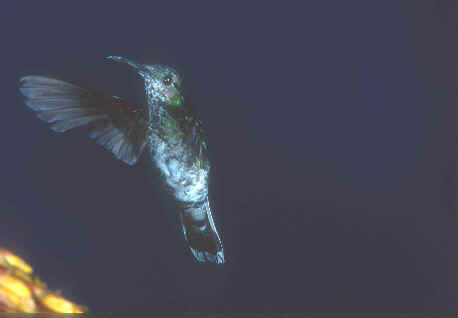
- Andean Hillstar ______ AR(*) CH(*)
EC
Oreotrochilus estella
SUBSPECIES:
Oreotrochilus estella
bolivianus ______ (subspecies
in central Bolivia)
O. e. bolivianus has black spots
on its belly stripe..
Oreotrochilus estella estella ______
(subspecies from southwestern Peru to northern Chile & northwestern
Argentina)
Oreotrochilus estella
stolzmanni ______
(subspecies in Ecuador and northern & central Peru; in Ecuador at the
extreme southern end of the country in the far-southern Cordillera Las
Lagunillas)
O. e. stolzmanni has a black
rather than brown ventral stripe.
It has been suggested that Oreotrochilus estella stolzmanni
deserves recognition as a species.
The Andean Hillstar is adapted to living at high altitudes, where it
feeds primarily on Chuquiraga spinosa.
It perches rather than hovers when taking nectar. It becomes torpid
overnight
The Andean Hillstar is one of the most common birds in its preferred
puna habitat.
- White-sided Hillstar ______
AR(*) CH(*) (species
described by Gould in 1847)
Oreotrochilus
leucopleurus
The geographic range of the White-sided
Hillstar is from southern Bolivia to south-central Chile and southern
Argentina.
- Black-breasted Hillstar ______
(species described by Gould in 1847)
Oreotrochilus melanogaster
The geographic range of the Black-breasted Hillstar is in central
Peru.
- Wedge-tailed Hillstar (nt) ______
Oreotrochilus adela
The geographic range of the
Wedge-tailed Hillstar is in southern Bolivia.
LAFRESNAYA
- Mountain Velvetbreast ______ EC(*)
VE(*)
Lafresnaya lasfresnayi
SUBSPECIES
Lafresnaya lasfresnayi
greenewalti ______
(subspecies in western Venezuela) (subspecies described in 1961)
Lafresnaya lasfresnayi lasfresnayi ______
(subspecies in western Venezuela and central & eastern Colombia)
Lafresnaya lasfresnayi liriope ______
(subspecies in northeastern Colombia)
Lafresnaya lasfresnayi rectirostris ______ (subspecies
in northern & central Peru)
Lafresnaya lasfresnayi saul ______
(subspecies in southwestern Colombia, Ecuador, northern
Peru)
COELIGENA
- Collared Inca ______ EC(*)
VE(*)
Coeligena torquata
SUBSPECIES:
Coeligena torquata conradii ______
(subspecies in eastern Colombia & northwestern Venezuela)
Coeligena torquata fulgidigula ______ (subspecies in
western Ecuador) (subspecies described by Gould in 1854)
Coeligena torquata margaretae ______ (subspecies
in northern Peru) (subspecies described in 1948)
Coeligena torquata torquata ______ (subspecies
from northwestern Venezuela to northern Peru; in Ecuador,
subspecies in the east)
(upper photo below, courtesy of Larry O'Meallie,
lower photo below by Marie Gardner during the FONT Ecuador Tour in
April 2014)
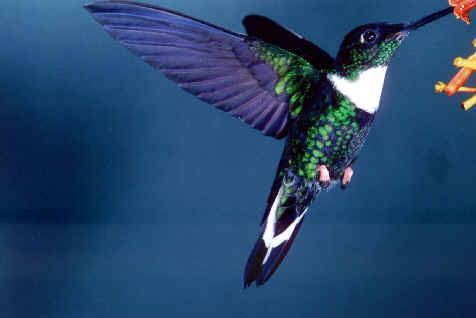
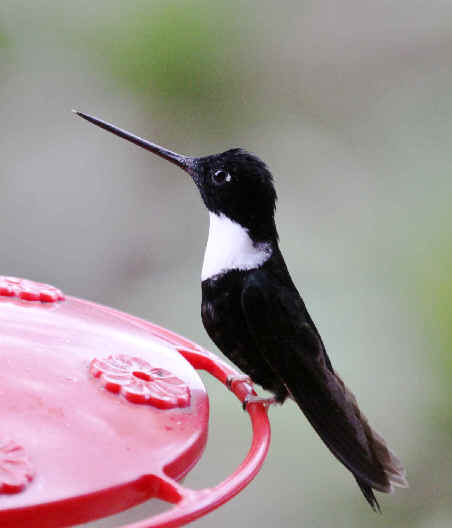
- Bronzy Inca ______ EC(*)
VE(*)
Coeligena coeligena
SUBSPECIES:
Coeligena coeligena
boliviana ______
(subspecies in Bolivia) (subspecies described by Gould in 1861)
Coeligena coeligena coeligena ______
(subspecies in northern Venezuela)
Coeligena coeligena columbiana ______ (subspecies
northwestern Venezuela and eastern & central Colombia)
Coeligena coeligena ferruginea ______
(subspecies in western & central Colombia)
Coeligena coeligena obscura ______
(subspecies in southern Colombia, Ecuador, and Peru)
Coeligena coeligena zuliana ______
(subspecies in western Venezuela & northeastern Colombia)
(subspecies described in 1953)
- Brown Inca ______ EC(*)
Coeligena wilsoni
The geographic range of the Brown
Inca is in western Colombia & western Ecuador.
- Black Inca (t2) ______
Coeligena prunellei
The geographic range of the Black
Inca is in north-central Colombia.
- Rainbow Starfrontlet ______ EC(*)
Coeligena iris
SUBSPECIES (the 2 here rather different):
Coeligena iris hesperus ______
(subspecies in southwestern Ecuador, in southern Chimborazo, Canar, and most of Azuay)
(subspecies described by Gould in 1865)
Coeligena iris iris ______ (subspecies in
southern Ecuador and northwestern Peru in Piura; in Ecuador, from southern Azuay south through El Oro and Loja)
(subspecies described by Gould in 1854)
OTHER SUBSPECIES:
Coeligena iris aurora ______ (subspecies in northwestern Peru in
Cutervo) (subspecies described by Gould in 1854)
Coeligena iris eva ______ (subspecies in northern Peru, on the
east slope of the western Andes)
Coeligena iris flagrans ______ (subspecies in Peru, on the west
slope of the western Andes) (subspecies described in 1951)
Coeligena iris fulgidiceps ______ (subspecies in northern Peru,
in the eastern Andes east of the Maranon River)
(photo below, courtesy of Larry O'Meallie)
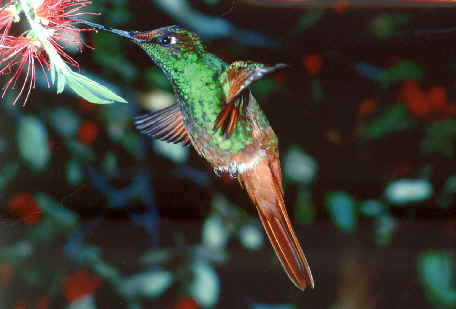
- Golden-bellied Starfrontlet ______
Coeligena bonapartei
SUBSPECIES:
Coeligena bonapartei
bonapartei ______ (subspecies
in eastern Colombia)
Coeligena bonapartei consita ______
(subspecies in northwest Venezuela & northeast Colombia)
(subspecies described in 1952)
Coeligena bonapartei orina ______ (subspecies
in north-central Venezuela) (subspecies described in 1953)
- Golden-tailed Starfrontlet
______ VE(*) (was part of the Golden-bellied
Starfrontlet) (originally described by Gould in 1848)
Coeligena eos
The geographic range of the Golden-tailed Starthroat is in western
Venezuela.
- Blue-throated Starfrontlet ______
Coeligena helianthea
SUBSPECIES:
Coeligena helianthea
helianthea ______ (subspecies
in Colombia)
Coeligena helianthea tamai ______
(subspecies in western Venezuela) (subspecies described in 1953)
- Buff-winged Starfrontlet ______
EC(*)
Coeligena lutetiae
The geographic range of the Buff-winged
Starfrontlet is from central Colombia to northern Peru.
The Buff-winged Starfrontlet takes nectar at many different flowers
with a long corolla, including species of Bomarea, Cavendishia,
Fuchsia, Nasa, and Tropaeolum. It also catches insects.
(photo below by Marie Gardner during the FONT tour in Ecuador in April
2013)

- Violet-throated Starfrontlet
______ (species described by Gould in 1846)
Coeligena
violifer
SUBSPECIES:
Coeligena violifer
albicaudata ______
(subspecies in southern Peru) (subspecies described in 1997)
Coeligena violifer dichroura ______ (subspecies
in southern Ecuador, and north, central, & western Peru)
Coeligena violifer osculans ______ (subspecies
in southeast Peru) (subspecies described by Gould in 1871)
Coeligena violifer violifer ______
(subspecies in northwest Bolivia)
- White-tailed Starfrontlet ______
Coeligena phalerata
The geographic range of the
White-tailed Starfrontlet is in northeastern Colombia.
ENSIFERA
- Sword-billed Hummingbird ______ EC(*)
VE(*)
Ensifera ensifera (the single member of its
genus)
The geographic range of the Sword-billed Hummingbird is in
western Venezuela & Colombia to northern Bolivia.
(photo below, courtesy of Larry O'Meallie;
below that, a print from a set of collector's cards in England in the
early 20th Century)
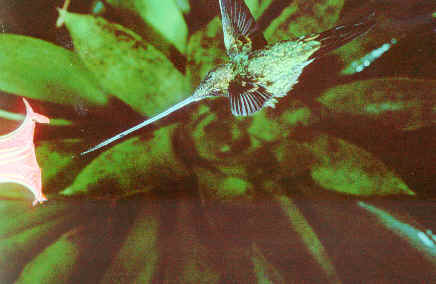
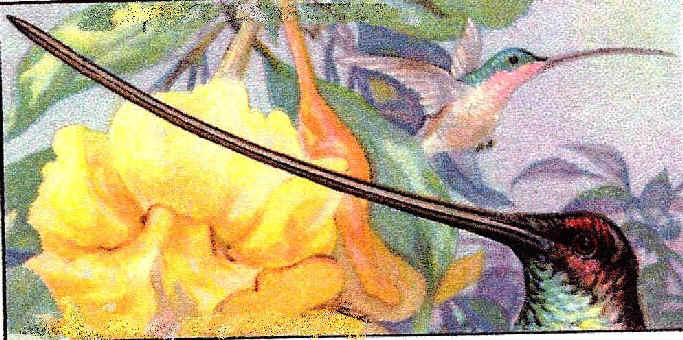
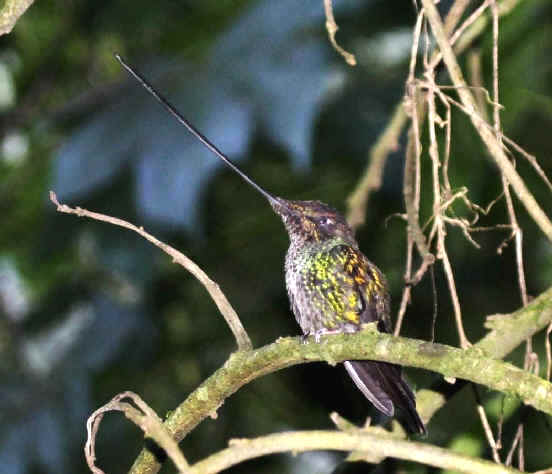
This Sword-billed Hummingbird was photographed during the
FONT tour in Ecuador in April 2013.
(photo by Marie Gardner)
PTEROPHANES
- Great Sapphirewing ______ EC(*)
Pterophanes cyanopterus
SUBSPECIES:
Pterophanes cyanopterus caeruleuus ______ (subspecies
in southern Colombia) (subspecies described in 1951)
Pterophanes cyanopterus cyanopterus ______ (subspecies
in north-central Colombia)
Pterophanes cyanopterus peruvianus ______
(subspecies in Ecuador, Peru, northern Bolivia)
The Great Sapphirewing is the second largest species
of hummingbird, after the Giant Hummingbird (below).
It is 6 inches in length.
The Great Sapphirewing often holds its wings outstretched as if for
balance. The large stiff wings cause the bird to appear to have a
"bat-like" flight.
(photos below by Marie Gardner during the FONT tour in Ecuador in
April 2013)
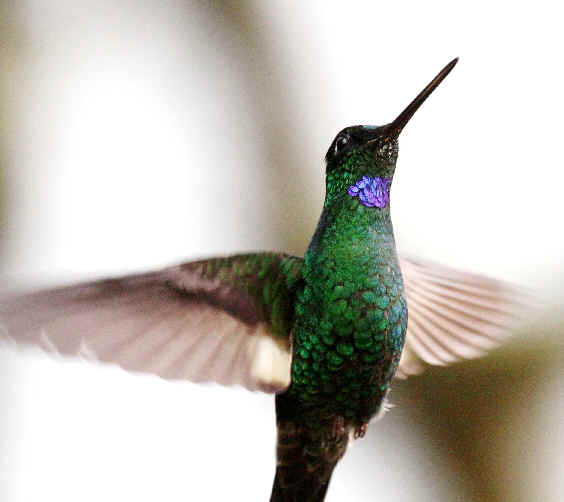
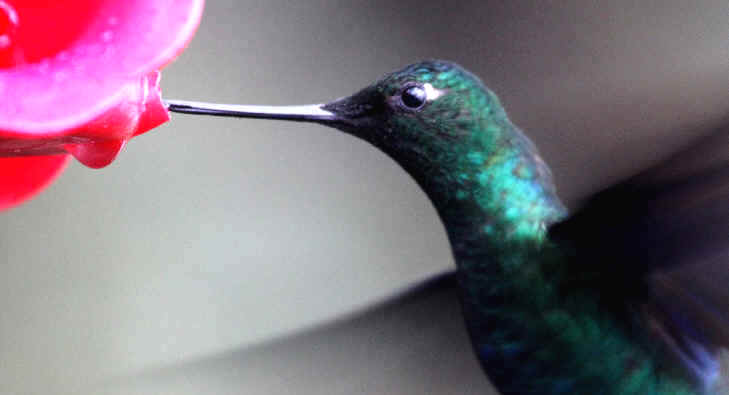
PATAGONA
- Giant Hummingbird ______ AR(*)
CH(*)
EC(*)
Patagona gigas
SUBSPECIES:
Patagona gigas gigas ______
(subspecies in central Chile & west-central Argentina)
Patagona gigas peruviana ______ (subspecies from
southwestern Colombia to northern Chile & northwestern Argentina)
The Giant Hummingbird feeds on large flower clusters,
usually perching as it does. It favors Agave and Puya flowers
and various cacti.
SEPHANOIDES
- Green-backed Firecrown ______ AR(*)
CH(*)
Sephanoides sephanoides
The geographic range of the Green-backed Firecrown is
in Chile & western Argentina.
- Juan Fernandez Firecrown (t1) ______
Sephanoides fernandensis
SUBSPECIES:
Sephanoides fernandensis fernandensis
______ (subspecies on Robinson Crusoe Island in the
Juan Fernandez Islands of Chile)
Sephanoides fernandensis leyboldi ______
(subspecies, now presumed extinct, on Alejandro Selkirk Island in the Juan
Fernandez Islands of Chile)
HELIANGELUS
- Gorgeted Sunangel
______ EC(*) (species described by
Gould in 1846)
Heiangelus strophianus
The geographic range of the Gorgeted Sunangel is in northwestern
Ecuador & southwestern Colombia.
The Gorgeted Sunangel is often close to thick cover, and feeds at low
levels, frequently piercing flowers with long corollas such as Psammisia
species.
(upper photo below, courtesy of Larry O'Meallie,
lower photo by Marie Gardner during the FONT tour in Ecuador in April
2013)
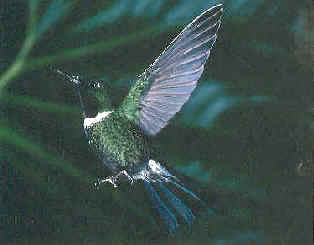
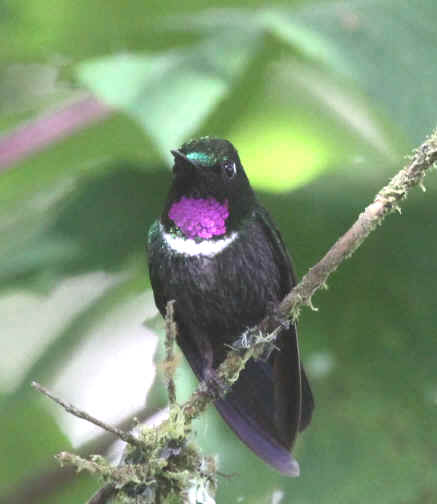
- Orange-throated Sunangel ______
VE(*) (species described by Gould in 1848)
Heliangelus mavors
The geographic range of the Orange-throated Sunangel is in
northwestern Venezuela & eastern Colombia.
- Amethyst-throated Sunangel ______
EC(*)
Heliangelus amethysticollis
SUBSPECIES:
Heliangelus amethysticollis amethysticollis
______ (subspecies in southern Peru & northwestern
Bolivia)
Heliangelus amethysticollis apurimacensis ______ (subspecies
in southern Peru, described in 2009)
Heliangelus amethysticollis decolor ______ (subspecies
in central Peru, described in 1951)
Heliangelus amethysticollis laticlavius ______
(subspecies in southern Ecuador & northern Peru)
(photo below by Marie Gardner during the FONT tour in Ecuador in April
2014)
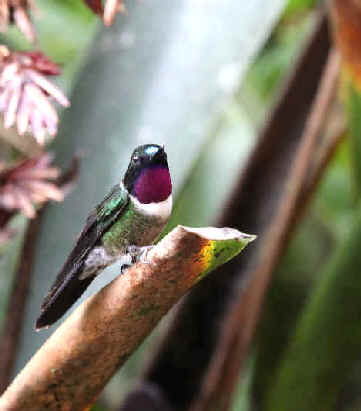
- Longuemare's Sunangel ______ VE(*)
(was part of the Amethyst-throated Sunangel)
Heliangelus clarisse
SUBSPECIES:
Heliangelus clarisse clarisse ______
(subspecies in western Venezuela & eastern Colombia)
Heliangelus clarisse spenci
Merida
Sunangel ______ VE(*) (subspecies
in northwestern Venezuela, in the Andes in Merida)
- Tourmaline Sunangel ______ EC(*)
Heliangelus exortis
The geographic range of the Tourmaline Sunangel is in
northwestern Ecuador & Colombia.
- Flame-throated Sunangel ______ EC(*)
(species
originally described by Gould in 1872)
Heliangelus micraster
The Flame-throated Sunangel has been considered part of the Tourmaline
Sunangel. Another name has been the Little Sunangel.
SUBSPECIES:
Heliangelus micraster cutevensis ______
(subspecies in northwestern Peru)
Heliangelus micraster micraster ______ (subspecies
in southeastern Ecuador & northern Peru)
(photo below by Marie Gardner during the FONT tour in Ecuador in April
2014)
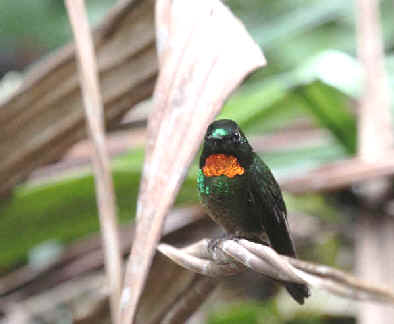
- Purple-throated Sunangel ______
EC(*) (species described by Gould in 1853)
Heliangelus viola
The geographic range of the Purple-throated Sunangel is in
southern Ecuador & northern Peru.
- Royal Sunangel (t2) ______ (species
described in 1979)
Heliangelus regalis
The geographic range of the Royal Sunangel is in northern Peru.
ERIOCNEMIS
- Sapphire-vented Puffleg
______ EC(*)
Eriocnemis luciani
SUBSPECIES:
Eriocnemis luciani baptistae ______ (subspecies
in the Andes of south-central & southern Ecuador) (subspecies
described in 2001)
Eriocnemis luciani catharina ______ (subspecies
in northern Peru)
Eriocnemis luciani luciani ______ (subspecies in
western Ecuador & southwestern Colombia)
Eriocnemis luciani meridae ______ (subspecies in
northwestern Venezuela, in the Andes in Merida) (subspecies described
in 2001)
Eriocnemis luciani sapphiropygia ______
(subspecies in central & southern Peru)
(photo below, courtesy of Larry O'Meallie)
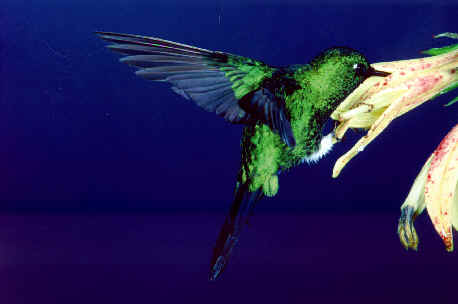
- Black-breasted Puffleg (t1) ______
EC(*)
Eriocnemis nigrivestis
The Black-breasted Puffleg has an extremely small range. It is
believed now to be confined to the northern ridge crests of Volcan
Pinchincha, in the Pinchincha province in Ecuador.
This species is one of the rarest of birds seen during FONT tours over the
years.
- Glowing Puffleg ______ EC(*)
VE(*)
Eriocnemis vestita
SUBSPECIES:
Eriocnemis vestita arcosi ______ (subspecies
in southern Ecuador & northern Peru) (subspecies described in
2001)
Eriocnemis vestita paramillo ______ (subspecies
in northwest Colombia)
Eriocnemis vestita smaragdinipectus ______
(subspecies in southern Colombia & eastern Ecuador) (subspecies
described by Gould in 1868)
Eriocnemis vestita vestita ______ (subspecies in
northwestern Venezuela & eastern Colombia)
- Black-thighed Puffleg (nt) ______
EC
Eriocnemis derbyi
The geographic range of the Black-thighed Puffleg is in
northwestern Ecuador & Colombia.
- Turquoise-throated Puffleg (t1)
______ EC
Eriocnemis godini
The geographic range of the Turquoise-throated Puffleg is in
northwestern Ecuador.
- Coppery-bellied Puffleg (nt) ______
Eriocnemis cupreoventris
The geographic range of the Coppery-bellied Puffleg is in
northwestern Venezuela & eastern Colombia.
- Golden-breasted Puffleg ______ EC(*)
Eriocnemis mosquera
The geographic range of the Golden-breasted Puffleg is in
northwestern Ecuador & Colombia.
- Blue-capped Puffleg ______
Eriocnemis glaucopoides
The geographic range of the Blue-capped Puffleg is from central
Bolivia to northwest Argentina.
- Colorful Puffleg (t1) ______
(species described in 1967)
Eriocnemis mirabilis
The geographic range of the Colorful Puffleg is in western
Colombia.
- Emerald-bellied Puffleg ______ EC
Eriocnemis alinae
SUBSPECIES:
Eriocnemis alinae alinae ______ (subspecies in
eastern Colombia & eastern Ecuador)
Eriocnemis alinae dybowskii ______ (subspecies in
northern & central Peru)
HAPLOPHAEDIA
- Greenish Puffleg ______ EC
Haplophaedia aureliae
SUBSPECIES:
Haplophaedia aureliae aureliae ______
(subspecies in central & eastern Colombia)
Haplophaedia aureliae caucensis ______
(subspecies in southeast Panama and the western & central Andes in
Colombia)
Haplophaedia aureliae cutucuensis ______
(subspecies in southern Ecuador) (subspecies described in 2000)
Haplophaedia aureliae russata ______ (subspecies
in northern & central Ecuador) (subspecies described by Gould in
1871)
- Buff-thighed Puffleg ______
Haplophaedia assimilis
SUBSPECIES:
Haplophaedia assimilis affinis ______
(subspecies in northern & central Peru)
Haplophaedia assimilis assimilis ______
(subspecies in southern Peru & northern Bolivia)
- Hoary Puffleg (nt) ______
EC(*)
(species described by Gould in 1851)
Haplophaedia lugens
Some consider Haplophaedia lugens to be a west-slope subspecies
of Haplophaedia aureliae.
UROSTICTE
- Purple-bibbed Whitetip (ph)
______ EC(*)
Urosticte benjamini
The geographic range of the Purple-bibbed Whitetip is from
western Colombia to southwestern Ecuador and northern Peru.
In Ecuador, the Purple-bibbed Whitetip is on the west slope of
the Andes, mostly from 2,700 to 4,800 feet above sea level.
The name Whitetip is derived from the white tips of the male's
central tail feathers. Those feathers are curved upwards making the white
area stand clear of the rest of the tail.
Otherwise the male is glistening green with a patchy whitish breast band.
The Purple-bibbed Whitetip and the Rufous-vented Whitetip (below)
are very similar to each other, with the Rufous-vented Whitetip being
just a little smaller.
These two birds have been said to be subspecific forms of the same species.
The Whitetip population in Peru has been considered a separate
subspecies, intermedia, and has
been classified, at different times, as being with either the Purple-bibbed
Whitetip or the Rufous-vented Whitetip.
Now, however what was the subspecies intermedia
is not recognized.
- Rufous-vented Whitetip ______
EC
Urosticte ruficrissa
The geographic range of the Rufous-vented Whitetip is in southern
Colombia and eastern Ecuador.
In Ecuador, the Rufous-vented Whitetip is on the east slope of
the Andes, from 3,900 to 6,900 feet above sea level.
The male Rufous-vented Whitetip has, as the name of bird indicates, a
russet undertail, that is not had by the male Purple-bibbed Whitetip.
Also, as noted above, the Purple-bibbed Whitetip and the Rufous-vented
Whitetip are on different sides of the Andes, the Purple-bibbed
on the west, and the Rufous-vented on the east.
Urosticte rufocrissa tends to
inconspicuous, and is most often encountered in mist-net captures.
OCREATUS
- Booted Racket-tail ______ EC(*)
VE(*)
(also called Racket-tailed Puffleg)
Ocreatus underwoodii
SUBSPECIES:
Ocreatus underwoodii addae ______ (subspecies in
Bolivia)
Ocreatus underwoodii annae ______ (subspecies in
central & southern Peru)
Ocreatus underwoodii discifer ______ (subspecies
in northwest Venezuela & northeast Colombia)
Ocreatus underwoodii incommodus ______
(subspecies in western & central Colombia) (subspecies described
in 1943)
Ocreatus underwoodii melanantherus ______
(subspecies in
Ecuador, on the west slope of the Andes)
Ocreatus underwoodii peruanus ______ (subspecies
in northeast Peru & in Ecuador on the east slope of the Andes)
(subspecies described by Gould in 1849)
Ocreatus underwoodii polystictus ______
(subspecies in northern Venezuela) (subspecies described in
1942)
Ocreatus underwoodii underwoodii ______
(subspecies in eastern Colombia)
More than 1 species may be involved:
White-booted Racket-tail ______
Ocreatus underwoodii
Buff-booted Racket-tail ______
Ocreatus addae
The Booted Racket-tail takes nectar from Palicourea, Inga,
and similar plants.
(the photo below of a Booted Racket-tail was taken by Marie Gardner
during the FONT tour in Ecuador in April 2013,
the subspecies is Ocreatus underwoodii melanantherus.)
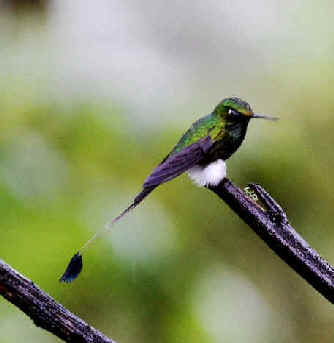
LESBIA
- Black-tailed Trainbearer
______ EC(*)
Lesbia victoriae
SUBSPECIES:
Lesbia victoriae berlepschi ______ (subspecies
in southeast Peru)
Lesbia victoriae juliae ______ (subspecies in
central & northern Peru, and in Ecuador in southern Loja)
Lesbia victoriae victoriae ______ (subspecies in
most of Ecuador and in Colombia)
(photo below, courtesy of Larry O'Meallie)
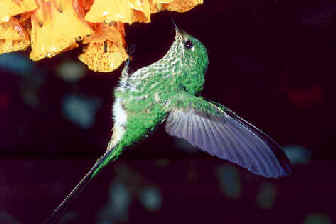
- Green-tailed Trainbearer ______
EC(*)
Lesbia nuna
SUBSPECIES:
Lesbia nuna eucharis ______ (subspecies in
central Peru)
Lesbia nuna gracilis ______ (subspecies in
Ecuador) (subspecies described by Gould in 1846)
Lesbia nuna gouldii ______ (subspecies in western
Venezuela & Colombia)
Lesbia nuna nuna ______ (subspecies in
southwestern Peru & northern Bolivia)
Lesbia nuna pallidiventris ______ (subspecies in
northern Peru)
SAPPHO
- Red-tailed Comet ______ AR(*) BL(*)
Sappho sparganura
SUBSPECIES:
Sappho sparganura sapho ______
(subspecies in southern Bolivia and in northern & western Argentina)
Sappho sparganura sparganura ______ (subspecies
in northern & central Bolivia)
POLYONYMUS
- Bronze-tailed Comet ______
Polyonymus caroli
The geographic range of the Bronze-tailed Comet is in
central & southern Peru.
TAPHROLESBIA
- Gray-bellied Comet (t2) ______
Taphrolesbia griseiventris
The geographic range of the Gray-bellied Comet is in
northwestern Peru in the Maranon Valley.
CHALCOSTIGMA
- Blue-mantled Thornbill
______ EC(*)
Chalcostigma stanleyi
SUBSPECIES:
Chalcostigma stanleyi stanleyi
______ (subspecies in
Ecuador)
Chalcostigma stanleyi versigulare ______ (subspecies
in northern Peru)
Chalcostigma stanleyi vulcani ______
(subspecies from southern Peru to west-central Bolivia) (subspecies
described by Gould in 1852)
(photo below, courtesy of Larry O'Meallie)
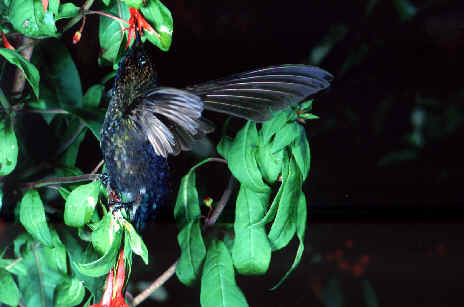
- Rufous-capped Thornbill ______ EC(*)
(species described by Gould in 1846)
Chalcostigma ruficeps
Chalcostigma ruficeps aureofastigatum
is no longer recognized as a valid subspecies.
- Olivaceous Thornbill ______
Chalcostigma olivaceum
SUBSPECIES:
Chalcostigma olivaceum olivaceum ______
(subspecies from southern Peru to central Bolivia)
Chalcostigma olivaceum pallens ______ (subspecies
in central Peru)
- Bronze-tailed Thornbill ______
Chalcostigma heteropogon
The geographic range of the Bronze-tailed Thornbill is in western
Venezuela & eastern Colombia.
- Rainbow-bearded Thornbill ______
EC(*)
Chalcostigma herrani
SUBSPECIES:
Chalcostigma herrani herrani ______ (subspecies
from southern Colombia to northern Peru)
Chalcostigma herrani tolimae ______ (subspecies
in western Colombia)
RAMPHOMICRON
The RAMPHOMICRON
thornbills have the shortest bills of any
hummingbird, averaging just over one-quarter inch.
- Black-backed Thornbill ______
Ramphomicron dorsale
The geographic range of the Black-backed Thornbill is in
northeastern Colombia.
- Purple-backed Thornbill ______
EC(*)
Ramphomicron microrhynchum
SUBSPECIES:
Ramphomicron microrhynchum albiventre ______
(subspecies in central Peru)
Ramphomicron microrhynchum andicola ______
(subspecies in western Venezuela)
Ramphomicron microrhynchum bolivianum ______
(subspecies in northern Bolivia) (subspecies described in 1984)
Ramphomicron microrhynchum microrhynchum ______
(subspecies in Colombia, Ecuador, northwest Peru)
OREONYMPHA
- Bearded Mountaineer ______ (species
described by Gould in 1869)
Oreonympha nobilis
SUBSPECIES:
Oreonympha nobilis albolimbata ______
(subspecies in west-central Peru)
Oreonympha nobilis nobilis ______ (subspecies in
south-central Peru)
OXYPOGON
- White-bearded Helmetcrest
______ VE(*) in northwestern Venezuela






![]()
 Codes:
Codes: NM: New Mexico, US
NM: New Mexico, US




















































